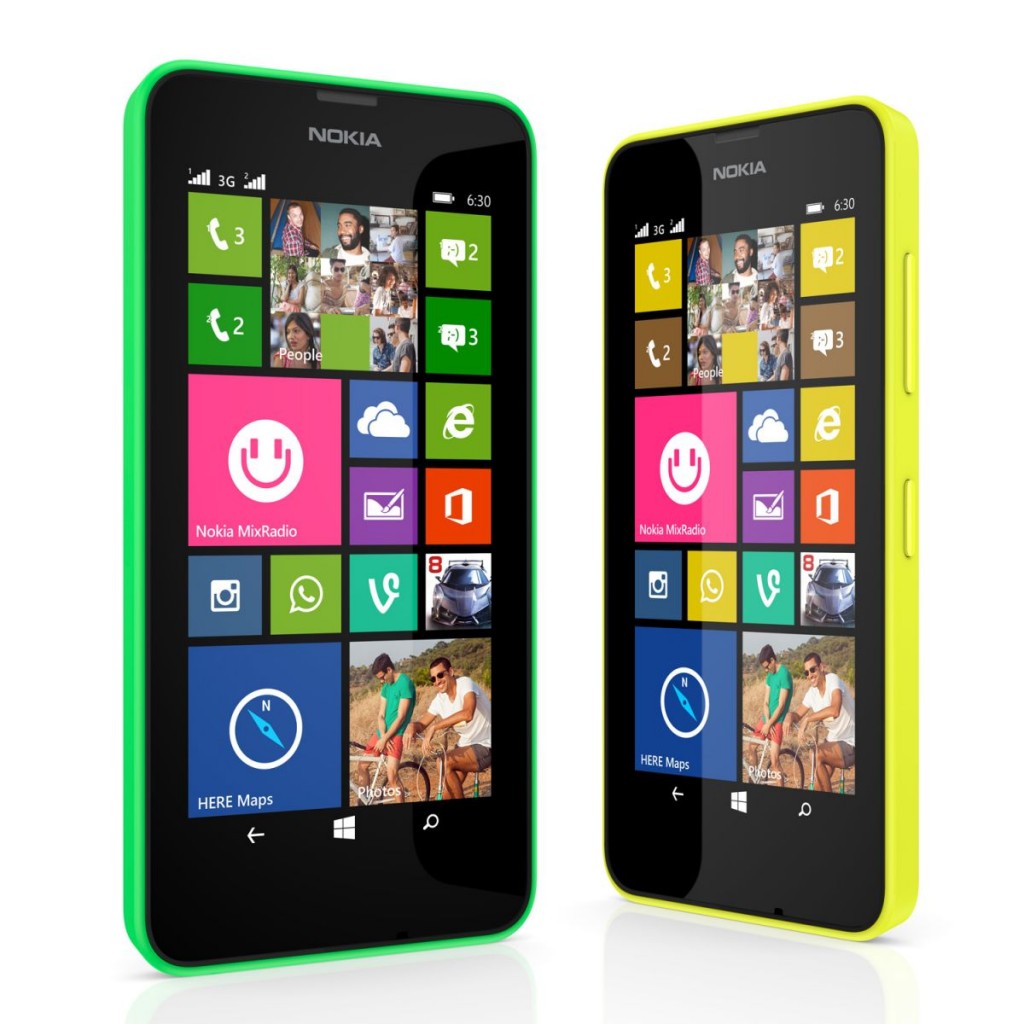
Andy69tech
Technophile/Electronics
Translate
Saturday 3 May 2014
Saturday 12 April 2014
this week
LG's Odin chip to soon go into mass production
More than one year after rumors about LG entering the chipset business started coming the company's 8-core Odin chip is about to enter mass production. As you may remember, the chipset will be based on ARM's big.LITTLE architecture with four Cortex-A15 cores using and four low-powered Cortex-A7 cores. The whole thing should utilize 28 nanometer manufacturing process
According to reports in the Korean media, even though the SoC isn't too far away from entering mass production, the LG G3 won't be rocking it. In fact, rumors have it LG is intends to use Odin to power its more budget offerings like the L-series.
LG is said to be partnering with TSMC, the same chip maker who is working on the Apple's A8 processor. Odin is rumored to be available in both quad-core and octa-core versions. The quad-core version of the chipset will allegedly pack an ARM Mali-T604 GPU. The octa-core one on the other hand, is said to sport ARM’s latest Mali-T760 GPU.
Later last year, the first benchmarks of the octa-core version of Odin surfaced. They suggested the chip was quite a performer, even though it was clocked at low speeds - 1GHz maximum.
Update 5 for Jolla’s Sailfish OS goes live with new features
 Jolla released update 5 for its Sailfish OS. Dubbed Paarlampi, the
new firmware brings new functionality to the OS, and addresses quite a
few of its shortcomings.
Jolla released update 5 for its Sailfish OS. Dubbed Paarlampi, the
new firmware brings new functionality to the OS, and addresses quite a
few of its shortcomings.Version 1.0.5.16 of Sailfish OS allows Jolla smartphone users to two-way sync Exchange contacts, as well as set a default account for sending emails. MMS functionality is finally brought to the OS, including the ability to receive carrier access point settings OTA.
Additionally, EXIF data is now stored in photos captured with Jolla’s camera. Users can also save GPS coordinates of the images they have captured with their handset.
Swipe to close gesture, visual interaction hints, and keyboard sounds wrap up the list of new features brought by the update. The gestures and the keyboard sounds can be tweaked in the device’s settings.
Bug fixes and improvements are plentiful too. The most notable one includes a security fix which addresses the OpenSSL “heartbleed” bug which set the web and the social networks on fire over the past week.
Android runtime has been optimized too. The new OS version allows for proper update support for installed apps, as well as improved 2D/3D performance among many others.
You can check out the full Sailfish Paarlampi update changelog by hitting the source link below.
Google releases official Project Ara Module Developers Kit
Google officially released its first Project Ara Module Developers Kit (MDK). The MDK gives a better understanding of the platform and provides developers with guidelines for creating components for the modular smartphone.
The MDK documentation gives us a glimpse at the three different Ara skeleton sizes – mini, medium and large. As expected, larger skeletons will be able to accommodate more Ara modules than smaller ones. Google will be the sole provider of Ara skeletons for the time being.

Project Ara devices will be available in different physical layouts. Users will be able to choose from touchscreen-only setups, as well as options with physical QWERTY keyboard, or even a number pad.

In order to ensure uniformity in Ara devices’ basic functionality, the MDK features guidelines for the most common modules such as processors, display units, Wi-Fi chips, batteries, etc. They cover even the physical appearance and measures of the modules. Third party add-ons will not need to adhere to the guidelines.
Google plans to release a series of Ara MDK releases this year, and hold a series of Developers Conferences (the fist one kicks off next week). The first Ara phones could hit the shelves as early as the first quarter of next year alongside a dedicated marketplace for additional modules. As we know already, Google targets a low entry price tag for the devices.
AUO makes highest resolution AMOLED screen to date
 AUO
is about to debut their 513ppi AMOLED display made for smartphones. The
unit boasts a QHD (2560x1440) resolution, which is supposed to provide
an amazing viewing experience.
AUO
is about to debut their 513ppi AMOLED display made for smartphones. The
unit boasts a QHD (2560x1440) resolution, which is supposed to provide
an amazing viewing experience.The display they are showing off is a 5.7” AMOLED screen that measures 0.57mm in thickness. AUO hasn’t only worked on the screen’s resolution, however, but boasts that touchscreen usability will be improved as well as they’ve implemented a unique design that allows for 10-point touch support for, you know, in case you want to use both hands or feet to interact with your smartphone.
AUO also plans on releasing some products for smartwatches as well: they made mention of a 1.6” AMOLED display for wearable tech that’s in development. The benefit of OLED tech for smartwatches is a significant selling point as AMOLED displays put less of a strain on battery life.
In addition to their portable tech screen aspirations, AUO will soon show off their curved, 4K LCD TV display units and automobile display units with wide viewing angles. But the real star of the show is the QHD AMOLED display.
With battery life an ongoing issue with the newest crop of smartphones having larger than life displays, AMOLED units provide some much needed relief. Is anyone excited about potentially rocking a QHD unit on their upcoming smartphone? Or do you think it’s all a numbers game at this point, and will only believe it when you see it in person?
Microsoft to release two GDR updates for WP8.1 this year
Microsoft separates Windows Phone 8 updates into major and minor ones – so far we've seen one major (8.1) and three minor ones (GDR 1, 2 and 3). The company is reportedly planning at least two GDR updates for WP8.1 this year.That's wholly unconfirmed for now, but a 3D Touch system is a possibility. We heard the first murmurs about it last year – it's essentially Samsung's Air Gestures from the Galaxy S and Note devices, at least that's what the first rumor made it sound like.

Another possibility is evolving Nokia's Refocus app (which got many imitators in this flagship generation). The rumor mill is talking of a dual-camera setup to create Lytro-like refocusable photos with just one shot. HTC tried just that and the results were not perfect.
The first of the GDR updates for Windows Phone 8.1 might come in the middle of this year (June/July) and the second one towards the end (November/December).
Nikon introduces 1 J4 interchangeable lens camera with focus on speed
Nikon unveiled a new addition to its interchangeable lens mirrorless cameras dubbed 1 J4. According to the company this is one of the fastest interchangeable lens compact cameras for continuous shooting with autofocus tracking currently on the market.
The compact shooter is said to come with many of the features recently introduced with the company’s more advanced 1 V3 model, except in a more affordable package.
The J4′s Expeed 4 processor allows for burst shooting at 20fps with continuous autofocus, and 60fps if you select a fixed focus point. Its 18MP CX-format sensor features an AF system that has 171 contrast and 105 phase detect points, which can focus on almost any area of the frame. Video can be recorded at 1080p@60fps, and at 720p@120fps, while the ISO range is 160 – 12800 for low-light environments.
Otherwise, the camera features an all-aluminum build and has a 3″ touchscreen display, and Nikon has moved the storage on the 1 J4 down to a microSD card slot in order to keep the size down.
The Nikon 1 J4 camera will be available in white, silver, black and orange, and will also come with accessories including an underwater case and camera flash. Pricing and availability are yet to be announced.
Ineda Systems develops ‘Dhanush’ chip for wearable devices
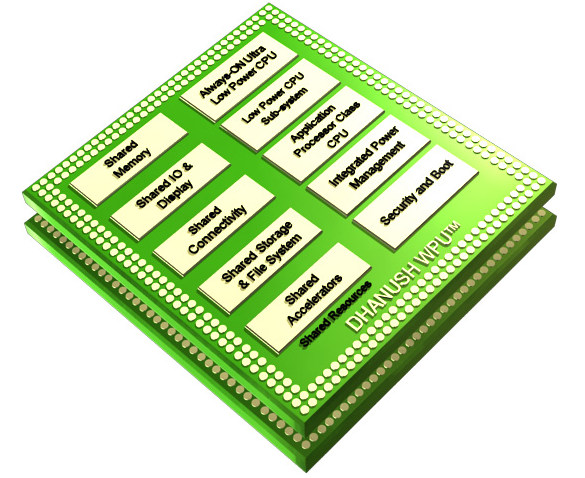
Ineda Systems has announced that it is developing a low power SoC (system on a chip) for wearable technology and Internet of Things. The Hyderabad based start-up revealed prototype of its SoC which is dubbed as Dhanush however, the start-up is calling these SoC as Wearable Processing Unit (WPU).

According to Ineda Systems, Dhanush consumes around 10 times less power than processors used in wearables today thereby enabling 30 days of always-on battery life. It is designed for an array of wearable devices like fitness bands, smart watches, glasses, athletic video recorders as well as Internet of Things.
Dhanush family of WPUs will be powered by the company’s Hierarchical Computing architecture, which is designed to enable multiple CPUs to run independently or together, depending on the tasks or applications they are running, said the company in a press release .The architecture is designed to ensure that each task gets the optimal amount of power they need at the lowest power consumption.

In 2013, Intel had announced its range of SoC billed as Quark that were also aimed at wearable devices. We all know that the year 2014 is attributed to be a year of wearable technology devices. In fact, a latest ABI Research estimates that manufacturers will sell around 90 million wearable devices like smartwatches, fitness activity trackers and products like Google Glass in 2014.
Samsung rebrands its SD card lineup to match SSDs
Samsung has seen some great success with its 840 PRO and EVO series of SSD drives, so much so that it’s decided to rebrand its microSD and SD cards to match that nomenclature.
The new Standard, EVO, and PRO cards from the Korean manufacturer will feature easy to distinguish colors which should help consumers in differentiating between the features and capabilities of the different classes.
Speaking of differences, the company has released a table that fully illustrates the new lineup:

As shown, the PRO models offer impressive transfer speeds, which could be useful for high throughput applications and 4K video recording. Video and photography enthusiasts will especially be drawn to this later category.
Samsung has specified that it has released the new naming scheme to make it easier for customers to differentiate between available varieties of SD cards, as the traditional Class rating system can be confusing to the average consumer.
What do you think? Will color-coding and naming their microSD and SD cards help Samsung sell more units?
SK Hynix develops 128GB DDR4 RAM module
South Korean chipmaker SK Hynix has announced that it has developed the industry’s most advanced double data rate 4 modules with 128 GB of capacity.
The new DDR4 modules are based on Through Silicon Via (TSV) technology and will significantly improve speeds and efficiency. TSV also allows the dynamic random access memory – popularly known as DRAM – to be connected with higher electrical efficiencies.
According to the manufacturer, the 128GB DDR4 module can reach speeds of 2,133 megabits per second as compared to DDR3′s 1,333 Mbps. Furthermore, it consumes less power as it works on 1.2 volts, while its predecessor was designed to run on 1.35 volts.
The mass production of the new 128GB DDR4 RAM model is expected to begin by the first half of 2015.
Twitter acquires Android Lockscreen app maker Cover
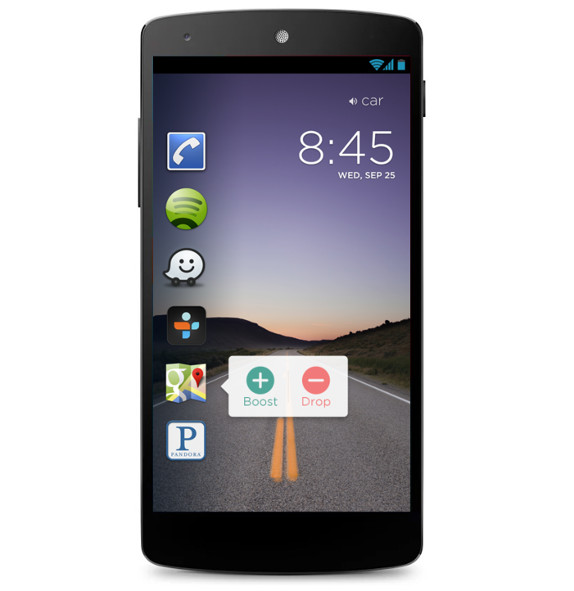
Twitter has acquired Cover, creators of Android lockscreen app Cover Lock Screen. The app was launched back in October last year and still remains in beta. It lets you set number of lockscreens for different context such as home, in the car, at work, and when you’re out that changes depending on time or location. The company has added a lot of features since it launch. It recently updated the app with boost and drop apps by long-pressing on individual app icons and improvements.
Acquiring the Android lockscreen app creators could mean that Twitter might also release a lockscreen app like Facebook Home. We can also expect something completely new from Twitter. Cover had raised $1.7 million in funding, notes TechCrunch. Both these companies did not disclose the final amount of the deal.
Commenting on joining Twitter, the creators of Cover on their official blog, said
It’s been an incredible journey, a journey that we’re excited to announce is taking a turn today as we bring the Cover team to Twitter to take these ideas even further. Twitter, like Cover, believes in the incredible potential of Android. They share our vision that smartphones can be a lot smarter — more useful and more contextual — and together we’re going to make that happen. We’ll be building upon a lot of what makes Cover great, and we’re thrilled to create something even better at Twitter.Cover has promised that Lock Screen app will be available in the Play Store for now and they will let the users know regarding any updates or changes.
OnePlus One to come with 2.5GHz Snapdragon 801 and 3GB RAM
OnePlus One is an upcoming smartphone from a Chinese manufacturer OnePlus. Most of the OnePlus folks are from Oppo and since they are from one of the globally recognized Chinese smartphone manufacturers, a lot of people from the tech community are expecting the OnePlus One smartphone to make a splash.
OnePlus has been teasing their smartphone for a long time now, but they haven’t revealed the phone in one piece. They have been giving out bits and pieces of information about the smartphone. Initially, they claimed that the device will be powered by Snapdragon 800 and will come with 2GB RAM. But now, they have announced that the OnePlus One smartphone will come with a more powerful Snapdragon 801 SoC (the same one which is found in Galaxy S5) clocked at 2.5GHz and 3GB RAM.
According to their official forum post, the specifications of the OnePlus One smartphone are as follows
- 5.5″ JDI 1080p display
- Snapdragon 801 (MSM8974AC – Quad-core at 2.5GHz)
- 3100+mAh battery (non-removable)
- Sony Exmor IMX214 6-Lens 13MP camera
- 5MP Front-Facing camera
- 3GB of RAM
- 16GB & 64GB Variants
- Stereo Speakers
- StyleSwap Covers – Multiple materials/textures
- Single-SIM card
- Global LTE
- GSM Only
- Something better than pre-orders
- No front branding
- 2 year CyanogenMod support
OnePlus have plans to take the veils off their flagship smartphone – OnePlus One on April 23. Lets see what we get.
Samsung SM-T800 specifications leaked – 10.5inch AMOLED tablet
Samsung is long said to be working on a AMOLED display tablet and there hasn’t been an official announcement yet. There have been rumors about a 7inch AMOLED display in the works, but now, SamMobile has posted about the specifications of a 10.5inch AMOLED display tablet from Samsung.
The model number – SM-T800 corresponds to Samsung’s upcoming 10.5inch WiFi tablet and it is rumored to be coming with a 10.5inch Super AMOLED display. The 10.5inch display will have a resolution of 2560×1600 pixels and like the recent flagship tablets, it is expected to be powered by the latest Snapdragon 801 SoC. It will also come with 2GB RAM. Like the recent Samsung smartphones, it will come with Android 4.42 KitKat out of the box.
Its other specifications include a 8MP rear camera and a 2MP front facing camera. There will be 16/32/64GB variants and it will come with a microSD card slot. The Samsung SM T800 will have a 7900mAh battery and come with Samsung’s latest Ultra Power Saving mode. Following the recent trend of Samsung products – there will be two variants – Snapdragon variant for the LTE markets and Exynos variant for other markets.
Samsung Galaxy Ace Style with 4-inch display, Android 4.4 announced

It is not clear if Samsung plans to sell the dual SIM variant of the Ace Style in some markets like they did for Galaxy Ace 3.
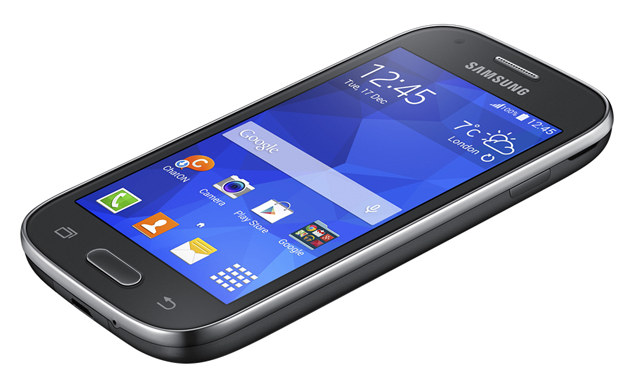
Samsung Galaxy Ace Style specifications
- 4-inch (480 x 800 pixels) capacitive touch screen display
- 1.2 GHz dual-core processor
- Android 4.4 (KitKat)
- 5MP rear camera
- 0.3MP (VGA) front-facing camera
- 3.5mm audio jack
- 3G, Wi-Fi 802.11 b/g/n, Bluetooth 4.0, GPS, NFC (Optional)
- 512MB RAM, 4GB internal memory, up to 64GB expandable memory with microSD
- 1500 mAh battery
Qualcomm unveils Snapdragon 810 and Snapdragon 808, coming in early 2015
Qualcomm unveiled the chipsets that will power a good number of next year's flagship and mid-range phones. The Snapdragon 810 and 808 both bring improvements in processor performance, 3D rendering and LTE.Both have 64-bit processors and use ARM Cortex A5x CPU cores instead of Qualcomm-designed Kraits. They leverage the big.LITTLE architecture, similar to the Samsung Exynos quad and hexa-core chipsets.
Note that these aren't the first 64-bit chipsets by Qualcomm, the first was the Snapdragon 410, followed by the 610 and 615.
Snapdragon 810
The Snapdragon 810 replaces the 805 as the top of the line chipset. It features four Cortex-A57 and four Cortex-A53 processor cores. Those are the Cortex-A15 and A7 replacements respectively, but the A57 should offer a 25-55% increase in performance at the cost of just 20% increase in power consumption. And the power consumption will probably actually be even as the 20% difference will be offset by the use of a 20nm manufacturing process, instead of 28nm.
The way the two new chipsets work is that the CPU cores are divided into two groups. All cores can work at the same time, but cores in a group must use the same frequency (the two groups can use different clocks though). This differs from the Krait designs where the clock speed of each core can be set individually.
In terms of GPU, the Snapdragon 810 has a brand new Adreno 430, which is advertised as 30% faster than the Adreno 420, which in turn is 40% faster than the Adreno 330 found in current Snapdragon 800/801 chipsets. The end result is something like an 80% performance increase over the current generation.

This chipset also has a hardware H265/HEVC encoder. The ISP uses 14-bit image processing, both of which can have tangible effects on camera image quality.
The 810 has a 64-bit bus to LPDDR-1600 RAM, that's 3,200MHz data rate and 25.6GB/s bandwidth.
Snapdragon 808
This one uses an A57/A53 combo but is a hexa-core processor – two Cortex-A57 cores and four Cortex-A53 cores. Given the performance benefits of the new cores, the 808 chipset should be about as good as the current quad-A15 designs.The Snapdragon 808 uses a new GPU too, Adreno 418. It slots under the Adreno 420 found in the Snapdragon 805, with 30% better performance than the Adreno 330.
This chipset has a 64-bit memory bus to LPDDR3-933 RAM, that's 1,866MHz data rate and 15GB/s bandwidth. The chipset has an ISP that can decode H265/HEVC but not encode it.
Both chipsets should be available in H1 2015.
LTE
The two new chipset feature 4G LTE Cat. 6 modems, which offer whopping maximum download speeds of 300MBps. To do that it bonds up to three 20MHz data pipes, compared to Cat. 4 modems that use a single 20MHz channel.
This, of course, relies on the carriers having enough available bandwidth. If there are not enough 20MHz channels, the modems can use 20MHz + 5MHz + 5MHz to boost the speed.
Sony announces A7S full frame camera with 4K video recording
After the α7 and the α7R, Sony has announced the newest member of its compact full frame cameras, the α7S. The ‘S’ in the name stands for ‘Sensitivity’, which means you can tell the camera all your life problems and it will totally get you. Actually, no. It means that the camera is really good in low-light conditions. And there is also a new 4K video recording mode, which is all the rage these days.
The α7S has a new 12.2 megapixel 35mm EXMOR CMOS sensor with a resolution of 4240 x 2832 (3:2). Sony is using a rather large sensor with a relatively low resolution, which means individual pixels are going to be pretty big. As mentioned before, the camera is also particularly sensitive to light, and boasts of an ISO range of 50 – 409,600. Sony also claims that the camera has an extremely wide dynamic range. All things combined, you can expect some really good results regardless of the lighting conditions you are shooting in.

The second cool feature is 4K video capture. The α7S can output 4K (3840 x 2160) video to an external recorder that you will have to get separately. If you want to record locally, you can choose one of the lower resolution options, such as 1080p60, 1080p30, 720p120 (5x slow motion), etc. The important thing with this camera is that it uses the output of the entire sensor to record videos, instead of just using a part of the sensor. The α7S also uses the XAVC S recording format at 50Mbps, found on Sony’s professional video cameras, along with AVCHD and MP4.
The α7S packs all this in a body that looks no different than the α7SR. On the back is a 1,230k dot, 3.0-inch tilting display, XGA OLED viewfinder, Wi-Fi, NFC, HDMI-out, microphone and headphone jacks.
Sony is yet to announce the pricing and availability of the α7S.
Google Play Edition treatment available for HTC One (M8)
HTC One M8
was announced a few weeks ago. It comes with a really beautiful
aluminum unibody shell, Snapdragon 801 chipset and dual-camera setup.
Naturally, it runs on the latest Android 4.4.2 KitKat OS plus HTC's
latest Sense 6.0 user interface.HTC One M8 Google Play Edition was made official on the announcement event too. It is more expensive than the regular One M8, it costs even more than the unlocked One M8 Developer Edition. However, if you don't want to pay $700 for the dedicated GPe, or you are limited by your contract with your carrier to stick with a regular One M8 - don't worry. There is now a way to convert your HTC One M8 to Google Play Edition!
There are a few things you should know before you proceed. First, you will need to erase the entire internal storage (NAND). To do so, you'll have to bypass HTC's security with a special tool. Then you must unlock the bootloader in order to flash a custom ROM. There is a step-by-step guide for the entire process, but it is not easy, and there is a chance you brick your HTC One M8. So, if you are not familiar with some of the tools, maybe you should stay away from such conversion.
You can opt for a rooted version of the vanilla Android ROM too. The ROMs and the guide are available over the source links below.
Nokia Asha Software Platform 1.4 update brings new camera features, MixRadio and more

Nokia has started rolling out new software update ( Software Platform 1.4) for Asha devices, Nokia Asha 500, 501, 502, 503, 230 and the dual SIM variants. This update brings a lot of new features such as Nokia MixRadio, voice-guided self-portrait and panorama features in camera, Parental control and more.
New features in Nokia Asha Software Platform 1.4 updateUsers with these Asha phones should get a push notification for the latest update. You can also manually check for update from Settings > Phone Update.
- Voice guided self-portrait and panorama modes in camera.
- Upload photos to your personal online gallery on OneDrive,includes 7GB of free storage
- New music app and Nokia MixRadio free music streaming service (Except Nokia Asha 230)
- Birthdays of the people in your social network now show up in Fastlane
- Re-tweets and Facebook likes also show up in Fastlane
- New Parental control feature can be enabled by setting a restrictions code for Browser and app installations.
- Power save mode will help your battery to last longer.
- Smart Dual SIM functionality (for Dual SIM phones)
- Contact groups
- Stability and performance improvements
Lava Iris Pro 20 with 4.7-inch qHD display launched
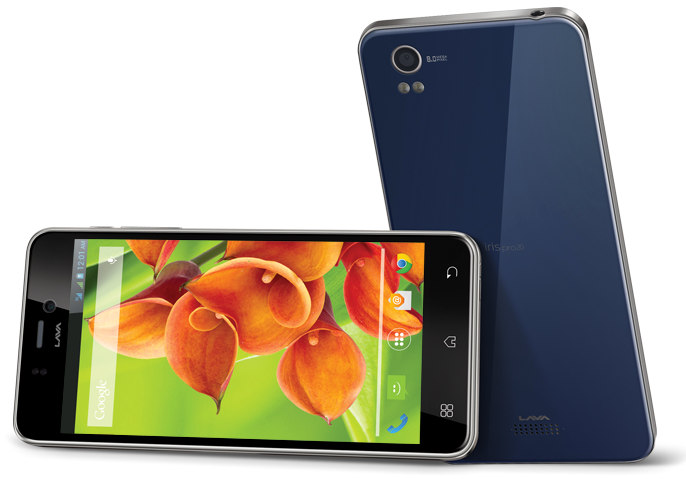
Lava has launched the Iris Pro 20, the latest smartphone in the Iris Pro 30. It has a 4.7-inch (960 x 540 pixels) qHD IPS display based on OGS technology and Corning Gorilla glass protection, powered by a 1.2 GHz quad-core processor and runs on Android 4.2 (Jelly Bean) OS. The phone is 7.7 mm thick and weighs just 112 grams. It has a 8-megapixel rear camera with dual LED flash and a 0.3-megapixel (VGA) front-facing camera.
It has CABC (Content Adaptive backlight control) screen brightness regulation technology that automatically reduces screen brightness for 30% more battery life, similar to the Iris Pro 30 that was launched earlier this year. It has dual SIM support with dual standby.
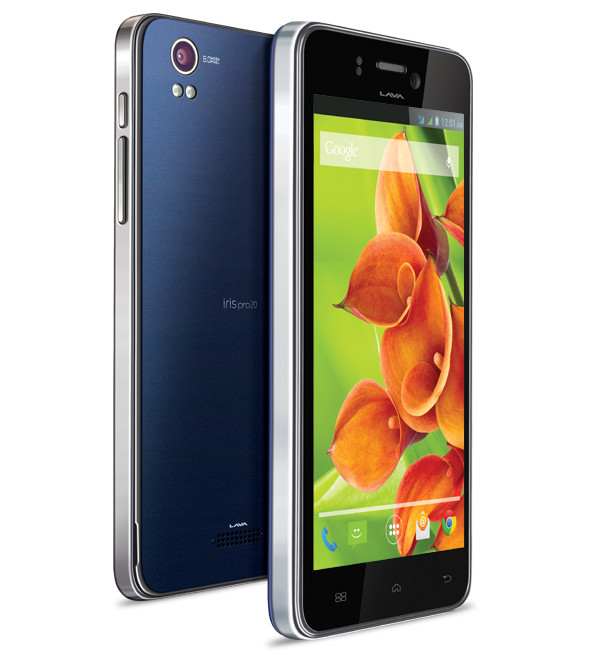
- 4.7-inch (960 x 540 pixels) qHD IPS display based OGS technology, Gorilla glass protection
- 1.2 GHz quad-core processor
- Android 4.2 (Jelly Bean)
- Dual SIM (normal + micro)
- 8MP rear camera with dual LED Flash
- 0.3 MP (VGA) front-facing camera
- Noise cancellation with dual microphones
- Dimensions: 138mm X 67.5mm X 7.7mm; Weight: 112 grams
- 3.5mm audio jack, FM Radio
- 1GB RAM, 4GB internal memory (2.43GB user memory), expandable memory up to 32GB with microSD
- 3G, WiFi 802.11 b/g/n, Bluetooth 4.0, GPS
- 2000 mAh battery
Nokia Lumia 1520 might get Miracast support, older WP devices have no chance
Microsoft introduced its latest mobile operating system, Windows Phone 8.1 a few days ago. Back at its announcement, the Redmond giant did mention that the newest OS supports Miracast, but we now know that the wireless screen casting service would require new hardware to work and will not be available on all WP 8.1 devices.
According to a tweet from Joe Belfiore, the head of Windows Phone group, Miracast would require new hardware and Nokia Lumia 1520 might be the only device to qualify. This also means that older Windows Phone devices have absolutely no chance of getting this new feature.
@sarang20067 WP8.1 supports Miracast but it will require new HW. MAYBE 1520 is new enough, I'm not sure. most WP8 hw won't be.
— joebelfiore (@joebelfiore) April 6, 2014
If you are wondering what Miracast is all about, then it is a
peer-to-peer wireless screen casting, which is formed via Wi-Fi Direct
connections that work similar to Bluetooth. This feature enables you to
wirelessly delivery audio and video to or from your desktops,
smartphones, tablets and other supported devices. Upcoming Android TV gets detailed before announcement
Leaked documents and screenshots obtained by The Verge reveal that Google is about to launch a new take on home entertainment. Dubbed Android TV, the service will take on the likes of Apple TV, Amazon Fire TV, and Roku.
According to the leaked documentation, Android TV is going to be “an entertainment interface, not a computing platform”. Its UI will be drastically different from the one found in Android smartphones and tablets. Google is reportedly hard at work on making the platform as easy for finding and enjoying content as possible.
The search giant has called for developers to build apps whose simplicity can match that of the scrolling cards-based Android TV interface. Some of the major apps which will be available include Google Play Movies, YouTube, Hangouts, Netflix, Pandora, Vevo, etc. Video games will also be supported.

Curiously, the report suggests that Android TV will be available alongside the massively popular, highly-affordable Chromecast HDMI dongle. This means that interested developers will potentially need to build two different interfaces for the duo of platforms.

Users will command the experience with a simple remote control. Support for gaming controllers will also be present, thus making the platform quite similar to Amazon Fire TV.
For the time being, there is no word on when Android TV will make its debut. Considering the look of the leaked screenshots, the wait might not be long.
Friday 4 April 2014
this week
Xolo Q1010i goes official with 5" 720p screen, 8MP camera
Xolo has announced its latest smartphone, the Q1010i. The newest mid-range offering is aiming to bring excellent camera experience at an affordable price tag.
The smartphone sports a 5-inch IPS display with a resolution of 1280 x 720 pixels. The Q1010i is powered by a MediaTek MT6582 chipset with a quad-core processor clocked at 1.3 GHz along with 1 GB of RAM. The device sports an 8 megapixel Sony Exmor R sensor with f/2.0 aperture, 1.4 micron pixel size and a 5-element lens.
Xolo Q1010i also features a 2 megapixel front facing shooter and 8 GB of internal memory with ability to expand it via microSD card. The connectivity options of the device include Wi-Fi 802.11 b/g/n and Bluetooth 4.0, but no 4G LTE support. The dual-SIM smartphone runs on Android 4.2 Jelly Bean and the juice for it is provided by a 2,250mAh battery.
Xolo Q1010i will cost INR 13,499 (about $225) and will be available in black. The device is expected to go on sale later this month.
Samsung SM-G906S with 5.2-inch QHD (1440×2560 pixels) display, Snapdragon 805 spotted in Benchmarks
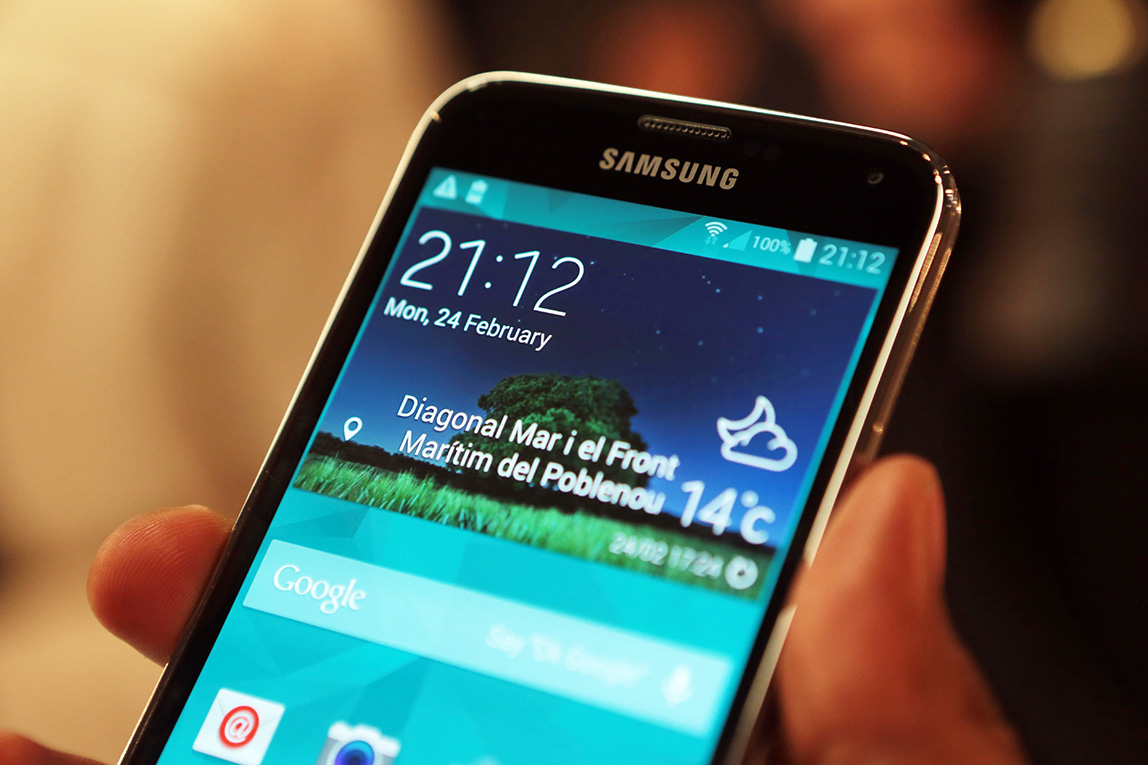
Samsung SM-G906S, an unknown devices with a 5.2-inch Quad HD (2560 x 1440 pixels) display has appeared on GFXBench. Samsung SM-G900S with a similar Quad HD display appeared on GFXBench back in December 2013, but Samsung did not release the phone. The SM-G900S had a Snapdragon 800 processor, but the SM-G906S would have a 2.5 GHz quad-core Qualcomm Snapdragon 805 processor with Adreno 420 GPU. It runs on Android 4.4.2 (KitKat).
Other specifications include 16-megapixel rear camera and a 2.1-megapixel front-facing camera, similar to the Galaxy S5. Unlike the Galaxy S5, this has 3GB RAM. It also has 32GB of internal storage and all the connectivity options similar to the Galaxy S5.
Earlier rumors suggested that a premium variant of the Galaxy S5 with metallic build would arrive this year, but JK Shin denied a premium Galaxy S5. Samsung already confirmed their plans to introduce 560ppi Super AMOLED displays for 2014. If the benchmark scores are true, this could be the rumored premium (F Series) smartphone as Samsung Vice Chairman Kwon Oh-hyun confirmed last month.
The Samsung Galaxy S5 would go on sale in India and several countries starting from next week. Samsung is also rumored to release the Galaxy S5 Active, S5 Mini and the S5 Zoom, similar to the S4 variants.
Xiaomi releases MIUI Express launcher Beta for Android
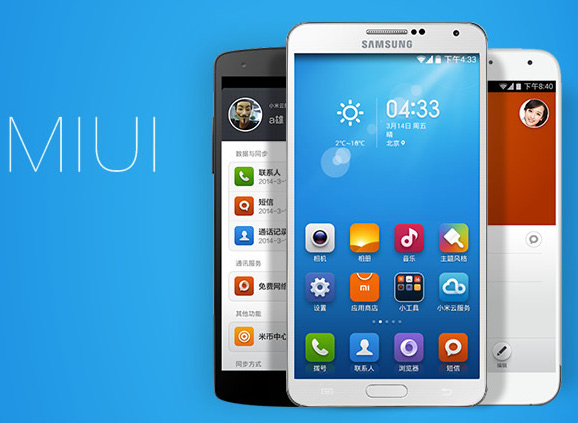
Xiaomi, a Chinese company popular for its affordable smartphones has released the beta version of MIUI Express launcher for Android. The company launched MIUI ROM for Nexus 7 last month. The launcher would be more suitable for those who don’t want to flash a ROM, but need a MIUI experience.
The launcher lets you set different homescreens, add widgets and shortcuts, just like any other launcher. You can change the look from the launcher-specific settings such as dynamic wallpaper, new icons and also use a password to hide apps. It also has separate dialer, SMS, and phonebook apps and a custom lockscreen. It has cloud backup to save contacts, text messages and call history. It also offers a range of gestures for the homescreen.
The MUI Express Beta is slightly different from the original MIUI launcher on Google Play. Samsung Galaxy Note 3, the Sony Xperia Z Ultra, and the HTC One are officially supported devices, but it works on any smartphone running Android 4.0 and above with at least 1 GB of RAM (2GB RAM recommended), says the company.
Download MIUI Express Beta (APK) for Android v1.0.1 from the official xiaomi website here.
Cyanogen Inc takes up a new identity with a new logo
CyanogenMod, one of the popular custom ROM options for Android users, became so famous that the developers behind the ROM decided to start a company to support the rom and that was the birth of Cyanogen Inc. Ever since, they have had support of Chinese manufacturers like Oppo and One Plus to directly install CM ROM on their smartphones.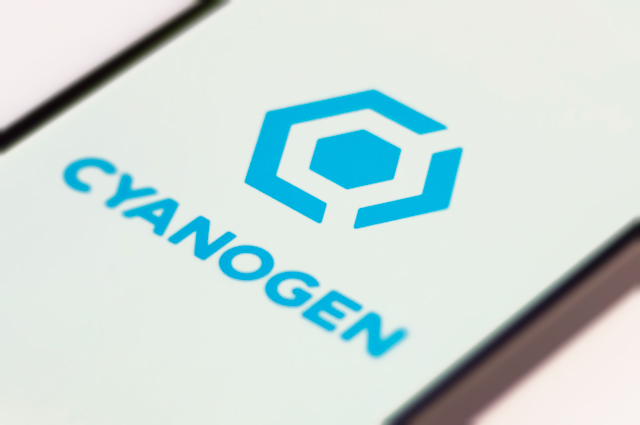
On April 3rd, Cyanogen Inc announced on their blog that they rebranding and changing their logo(again). The new logo is more of symbols rather than characters which used to be the trademark of CM ROM. They have explained in depth why they have chosen the new logo and new look.
Cyanogen Inc now focuses up on three core values – Customization, Security and Open Source. You may wonder what happened to “Cid”. Cid used to be the alien mascot for the company and was supposedly their logo. But now that they have adapted a new logo, they now tell that “cid” belongs to the community.
Lava QPAD e704 with 7-inch display, quad-core Broadcom processor launched for Rs. 9999
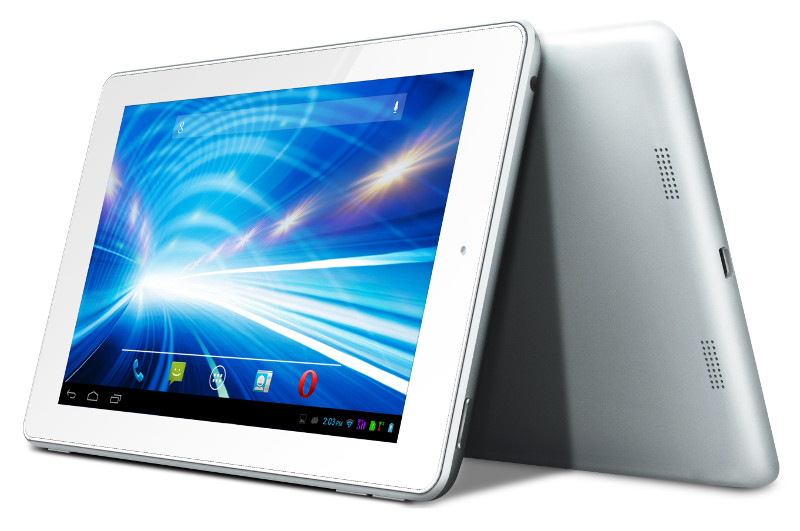
Lava has launched QPAD e704, the company’s first tablet in the QPAD series. It has a 7-inch (1024 x 600 pixels) display, powered by a 1.2 GHz quad-core Broadcom (BCM28155) processor with Videocore IV GPU and runs on Android 4.2 (Jelly Bean). It has a 3-megapixel rear camera and has a 0.3-megapixel (VGA) front-facing camera.
It has Dual SIM support, 3G connectivity and support for voice calls. It packs a 3500 battery that promises up to 300 hours of standby time and up to 10 hours talk time. We had already seen smartphones with this quad-core Broadcom chip, looks like this is one of the first tablets to feature this chip.
Lava QPAD e704 Specifications
- 7-inch (1024 x 600 pixels) capacitive 5-point multi-touch display
- Android 4.2 (Jelly Bean)
- 1.2 quad-core Broadcom (BCM28155) processor with Videocore IV GPU
- 3.2MP rear camera
- 0.3MP (VGA) front-facing camera
- 8.8 mm thick and weighs 200 grams
- 3.5mm audio jack
- 3G (via SIM card slot), WiFi, Bluetooth 3.0, HDMI V1.4, GPS + GLONASS
- 1GB DDR3 RAM, 4GB internal memory , 32GB expandable memory with microSD
- 3500 mAh battery
MTS Blaze 4.5 Dual SIM (CDMA + GSM) smartphone launched for Rs. 9999

MTS partnered with Micromax to launch the Micromax Canvas Blaze MT500 few months back and the Micromax Canvas Blaze HD EG116 went on sale last month. Both these have Dual SIM (CDMA + GSM) support. The MTS Blaze 4.5 is manufactured by ZTE.
MTS Blaze 4.5 specifications
- 4.5-inch (854 x 480 pixels) touch screen IPS display
- 1.2 GHz quad-core Snapdragon processor
- Android 4.1 (Jelly Bean)
- Dual SIM (CDMA + GSM)
- 5MP auto focus camera with LED Flash
- 0.3MP (VGA) front-facing camera
- 3G (EVDO Rev.A /HSDPA), Wi-Fi 802.11 b/g/n, Bluetooth 3.0 , GPS
- 3.5mm audio jack, FM Radio
- 1GB RAM, 4GB internal memory, expandable memory up to 32GB
- 1600 mAh battery
Samsung ATIV SE Windows Phone 8 handset official, coming to Verizon on April 12th
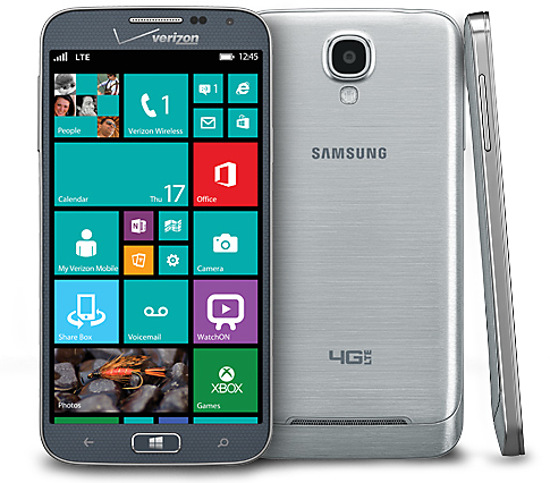
Other features are similar to the Galaxy S4, including a 13-megapixel rear camera with LED Flash, Full HD video recording, 2-megapixel front-facing camera, 2GB RAM, 16GB internal memory with expansion slot and a 2600 mAh battery.
It also has Samsung WatchON app and Infrared LED similar to the Galaxy S4 to control your TV and ATIV Beam that uses NFC to share files with other NFC-enabled Android smartphones. Since Microsoft has announced that it would upgrade all the Windows Phone 8 handsets to 8.1, the ATIV SE should also get the update eventually.
Samsung ATIV SE Specifications
- 5-inch Full HD (1920×1080 pixels) Super AMOLED display at 441ppi
- 2.3 GHz quad-core processor
- Windows Phone 8
- 13MP rear camera with LED Flash, BSI sensor and Full HD video recording
- 2MP front-facing camera
- 8.3 mm thick and weighs 135 grams
- 2GB RAM, 16GB internal memory, expandable up to 64GB with microSD
- Infrared LED for smart TV remote
- 4G LTE, Wi-Fi 802.11ac (HT80), Bluetooth 3.0, GPS and NFC
- 2600 mAh Battery
Universal apps are coming to Windows on Phones, PCs, Tablets and Xbox

Among the myriad of announcements Microsoft made at its Build 2014 keynote is one small but highly important detail. With the Windows Phone 8.1 operating system moving to a WinRT layer, all the Microsoft platforms now run on the same runtime, which includes all the devices like a PC, a tablet, a phone, and yes, even the Xbox One. Powered by a common runtime, developers will be able to target all these devices with a shared set of code that will work across all the platforms, like for example notifications, in-app security and so forth. This also means that users can buy an app from one store and use it on another, although the interface will change according to the form factor.
Making it the first time for a single runtime to have a target of this breadth, Microsoft is also updating its Visual Studio development tool to support this, with easier targeting and deployment on all of its platforms. Basically, an app developer will be able to share a big chunk of code like business logic, for Windows, Windows Phone and Xbox, with device specific interface and code separately adapted for the respective platforms. This enables developers to target a wider audience with common code and even tailor different experiences for the same app on different screens. For example, the Windows app could have more information density than the Windows Phone or the Xbox app. But these are not the only platforms a developer could target, because Windows is coming to wearable devices too, which will be based on the same runtime.
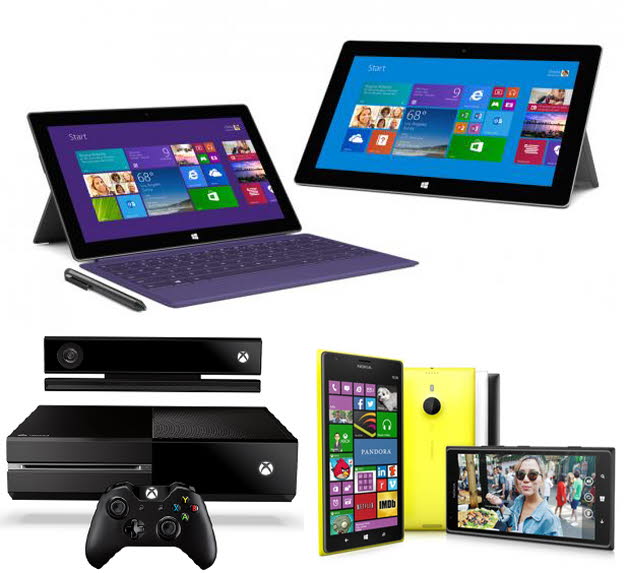
One of the most important demos showing off the universal apps capability was the new touch Office Suite for Windows and Windows Phone, which basically run off the same code. While the user interface was pre-alpha code, it still showed off powerful performance and a touch-first interface, on the lines of what they had shown with the Office for iPad app. Connected by the cloud, both the platforms could display the same app with the same presentation(the demo was powerpoint) and effects, indicating that the code is largely the same. Another app that was showed off was “Khan Academy” which works across Windows, Windows Phone as well as the Xbox One, with Kinect-specific gestures for the latter. The common core, an update store and shared code between platforms finally brings all the Microsoft platforms closer, and it will get even tighter once Microsoft removes the small niggles associated with the current form.
Xolo Q2500 PocketPad with 6-inch HD display launched
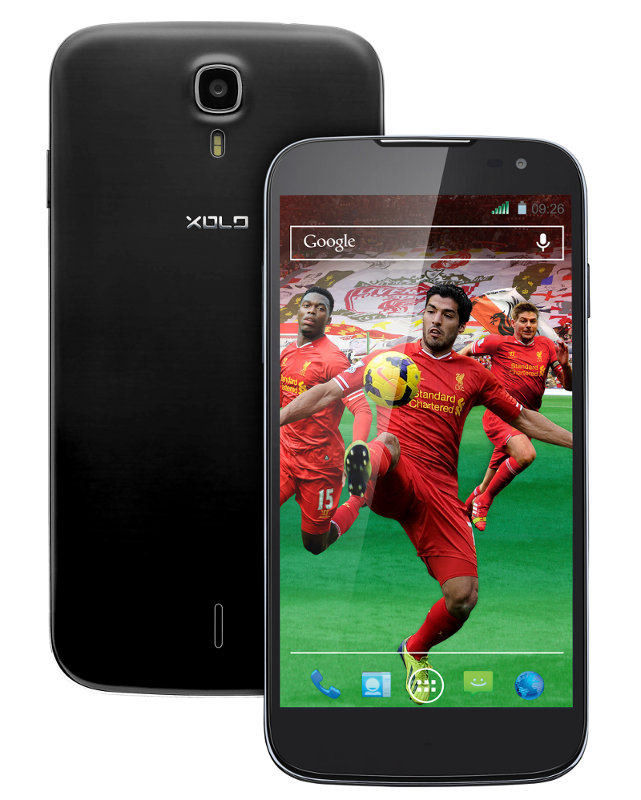
It has a 8-megapixel auto focus rear camera with BSI sensor, LED Flash, 1080p full HD video recording and a 2-megapixel front-facing camera. It comes with dual SIM support with dual standby, 1GB RAM and packs a 3000 mAh battery.
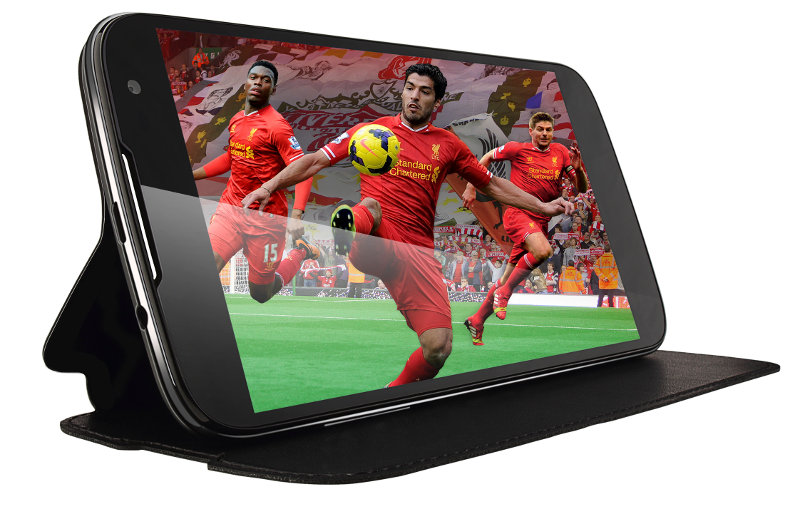
Xolo Q2500 PocketPad Specifications
- 6-inch (1280 x 720 pixels) HD capacitive touch screen IPS display
- 1.3 GHz quad-core MediaTek MT6582 processor with 500 MHz Mali 400MP2 GPU
- Android 4.2 (Jelly Bean), upgradable to Android 4.4 (KitKat)
- Dual SIM (GSM + GSM)
- 8 MP rear camera with BSI sensor, LED Flash, 1080p video recording
- 2MP front-facing camera
- 8.5mm thick
- 3.5mm audio jack, FM Radio
- 1GB RAM, 4GB internal memory, expandable memory up to 32GB with MicroSD
- 3G, WiFi 802.11 b/g/n, Bluetooth, GPS, USB OTG
- 3000 mAh battery
HERE Drive+ with global navigation will be free for all Windows Phone 8.1 handsets
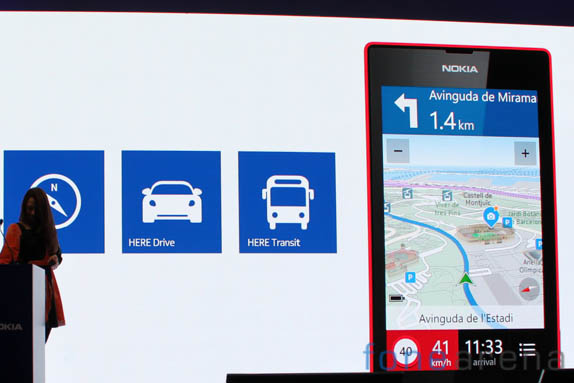
HERE, the location-based service from Nokia announced HERE Drive, HERE Transit and HERE Drive+ last year. HERE Drive came pre-loaded with Nokia Lumia smartphones out of the box and was available for free from Nokia Store for other smartphones. HERE Drive+ app was launched for free with select 9 series and 8 series smartphone ,but it was paid with other Nokia Lumia and other Windows Phone 8 devices.
HERE has extended free HERE Drive+ voice guided navigation benefits in 97 countries for all Windows Phone 8.1 devices. This would let entry-level Nokia Lumia 520 or any Windows Phone smartphones from Samsung or HTC running Windows Phone 8.1 can get HERE+ for free. HERE Transit is also free for all the WP 8.1 users.
HERE Drive+ app with global navigation license was previously priced at 15.49 EUR for some Lumia devices and 34.99 EUR for all the other Windows Phone devices.

The HERE app would also be updated with 3D view of building in select countries, in addition to 3D landmarks, aerial images, two fingers gestures to rotate the map and tilt to activate the 3D mode . HERE Drive+ would also bring the most expected long press to set destination feature.
The HERE Drive+ and all the new features would be available with Windows Phone 8.1 update.
Nokia MD-12 portable wireless speaker with NFC announced
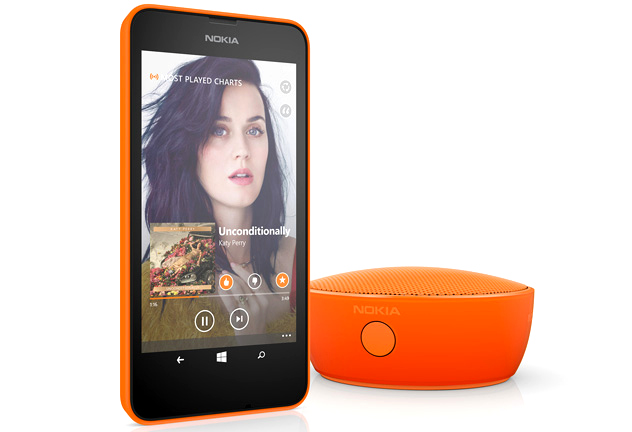
Nokia has announced Nokia MD-12, the company’s new portable wireless speaker. It has NFC support to pair your smartphones easily and the built-in vibrating actuator on the base promises thumping bass when placed on most surfaces. It also has a built-in rechargeable battery that promises about 15 hours of playback on full charge. It weighs just 180 grams.
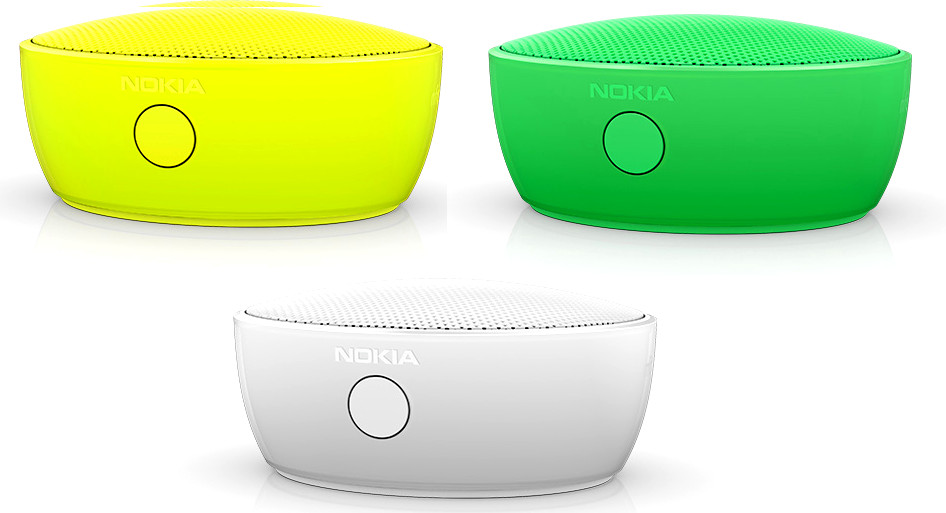
It has a microphone, so that you can use it as a speakerphone once your phone is connected to the speakers. It also has a AUX in port and comes with a cable in the box to connect other devices to the speakers. Nokia has not revealed any technical specifications of the device. The Nokia Device Hub app would let you manage the speaker and other connected accessories, offers app recommendations for your accessories and lets you see where you used them last time, in case you misplaced it, says the company.
The Nokia MD-12 wireless speaker would retail for 39 Euros (Rs. 3210 approx.) and comes in yellow, green, orange and white colors. It is expected to go on sale some time in Q2 2014.
Lumia Cyan update brings more features to Nokia’s Windows Phones
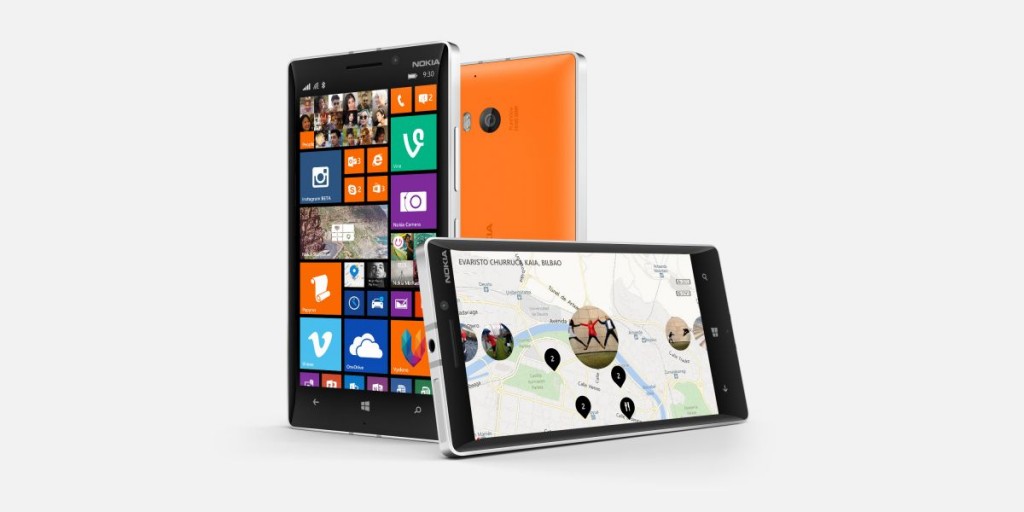
It has been a known fact that Nokia bundles its own software additions onto the Windows Phone build, which we call the device specific firmware. Likewise, Nokia will be releasing the Lumia Cyan update to its devices, to run on top of Windows Phone 8.1. This update brings more Nokia specific features on top of the default Windows Phone experience. After Amber and black, Cyan is the additive experience Nokia continues to provide on its Windows Phone devices. Some of the features added to Nokia’s firmware are enhancements to the Nokia camera app, updates to some photo apps and audio specific features for some devices.
Read more about Windows Phone 8.1
Firstly, it brings the enhanced Lumia imaging experience. This means a better camera interface, which now includes its own camera roll that supports all types of images from within the app, even the likes of cinemagraphs and refocus images. Then there are the easily accessible filters from creative studio, Nokia Storyteller video slideshow and more. The Nokia Lumia 630 and 635 also incorporate a “sensor core” which is much like the M7 from Apple, that has all the sensors that can record data for fitness. So, the bing fitness app could technically gather steps data and more from the sensor core.
Device specific enhancements include the new Dolby Surround Sound support for video recording on the Nokia Lumia 1520 and the newly launched Nokia Lumia 930, which incorporate the same set of HAAC mics for stereo recording. Also included is the Miracast support on the same devices, which is surprisingly a Nokia specific feature. All these enhancements are currently Nokia specific while the previous exclusives like double tap to wake, Here Drive+ are now available for Windows Phone, so it’s only about time when all the features are ported over. We will bring you a video of these features soon, so hang on until then and let us know what you think of these additions in the comments section below.
Nokia Lumia 630 dual SIM Windows Phone 8.1 handset announced
Rounding up the entry level Windows Phone 8.1 handset segment is the
newly announced Lumia 630 handset. The phone will ship in both single
SIM and dual SIM variants. The phone shares internals with the other
budget handset announced i.e. the LTE packing Nokia Lumia 635. Internally, the phone is powered by a 1.2 Ghz Snapdragon 400 processor and a surprisingly limited 512MB of RAM. Both variants of the Lumia 630 will ship with 8GB of storage that can be expanded via the micro SD card slot. Over on the front, the phone has a 4.5 inch FWVGA display covered with Gorilla Glass 3. The Lumia 630 along with the 635 are the first devices to have on screen buttons instead of the capacitive controls seen so far on Windows Phone devices.
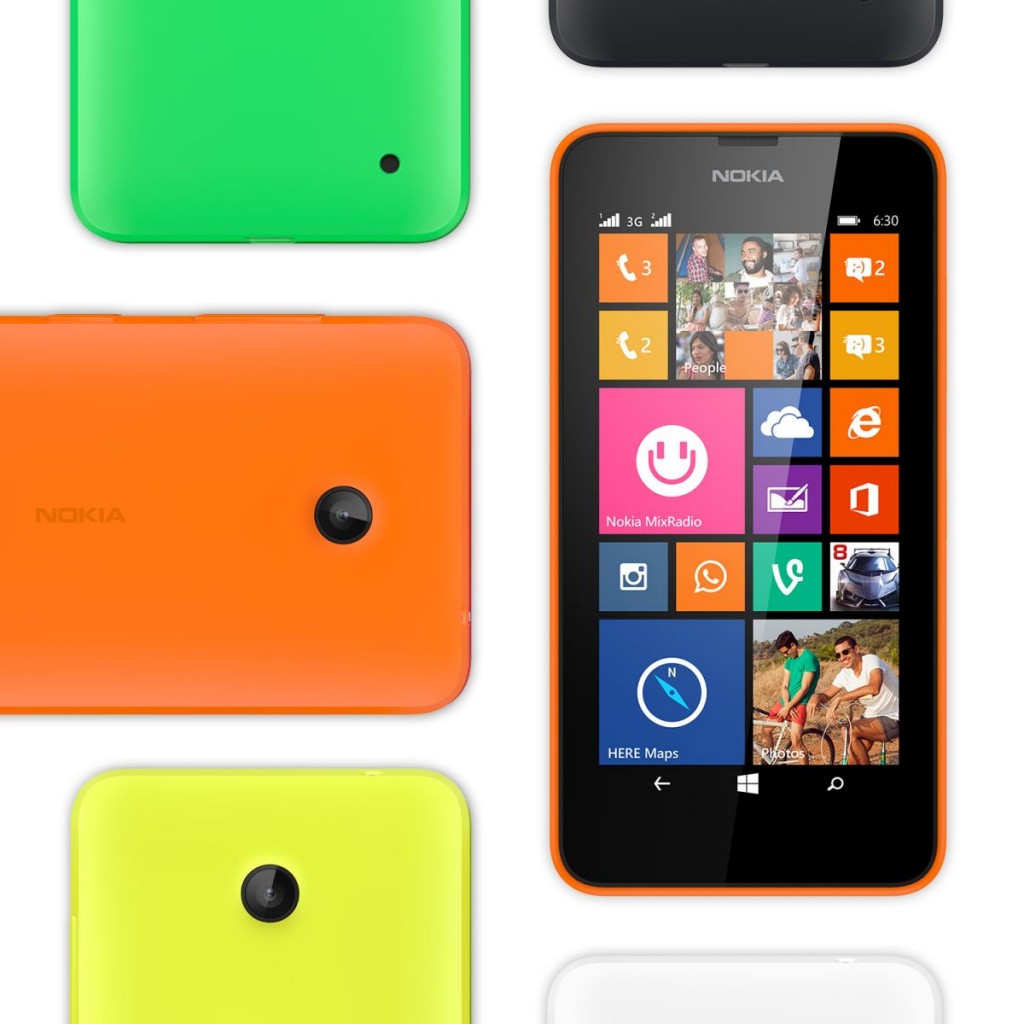
The phone has a 5MP AF capable camera unit at the back and will also support SensorCore. SensorCore is a chipset based function that tracks your activity data throughout the day and integrates it with the Bing Health & Fitness application. Running Windows Phone 8.1, the handsets will have proper integration for dual SIM functionality and will distinguish between the two lines by using distinct color identities. The Nokia Lumia 630 is priced at $159 for the 3G enabled single SIM variant while the dual SIM version will be priced at $169. The phone will retail in a range of colors including green, yellow, orange, white and black.
Nokia Lumia 635 with 4.5 inch screen and Windows Phone 8.1 announced, brings LTE connectivity for $189
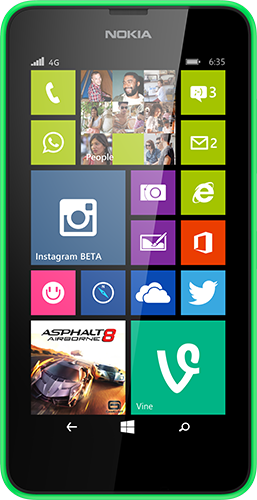
While the Nokia Lumia 930 is the company’s flag bearer for Windows Phone 8.1, the entry level segment remains critical. To meet the demands of the audience in this category, Stephen Elop today announced the Lumia 635 alongside the Lumia 630 today. The phone’s trump card is that it brings LTE connectivity at an exceptionally low price point.
The specifications of the phone include a 1.2 Ghz Snapdragon 400 processor paired with a rather abysmal 512MB of RAM. Built in storage is 8GB and you’ll be able to expand that via the microSD card slot. On the front, the device has a 4.5inch FWVGA display with a Gorilla Glass 3 covering on top of it. Something unique here is that alongside the Lumia 630, the 635 is the first Windows Phone device to have onscreen controls. It will be possible for developers to decide if they want to allow users to swipe away the controls in applications.

Nokia Lumia 930 with 5inch Full HD display, 20MP PureView camera announced

At Microsoft’s BUILD conference, Stephen Elop took the stage and announced the new Nokia flagship ie the Lumia 930. The phone will ship with the latest release of Windows Phone dubbed as Windows Phone 8.1. Essentially the international variant of the Lumia Icon, it brings top of the line specifications with a very cool new design that is a departure from the Fabula design language.
The phone has a 5 inch full HD display at the front and is being powered by a 2.2Ghz Snapdragon 800 processor. Users will get 32GB of storage onboard though unfortunately this cannot be expanded. The camera is a PureView module similar to that on the Lumia 1520 and is being accompanied by a dual LED flash. As you’d expect, the phone has built in optical image stabilization and will also come with the four directional microphones that were present on the Lumia 1520, Lumia Icon. Additionally it will have a new SensorCore feature that will gather distance and additional activity related data and tie it into Microsoft’s Bing Health and Fitness apps. The SensorCore chip should function similar to the M7 unit on the iPhone 5s. The phone also includes Qi based wireless charging to power it’s 2,420 mAh battery.
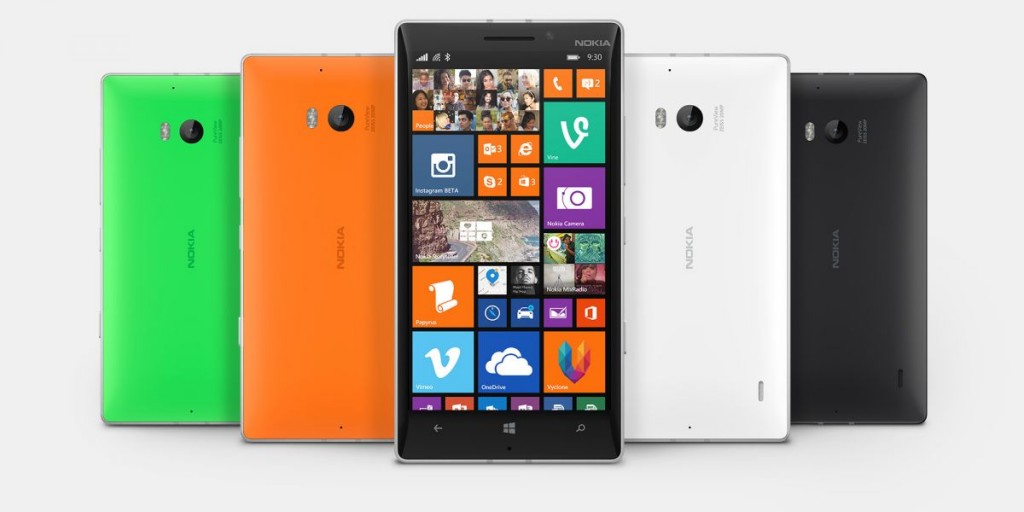
Windows Phone 8.1 is official, here are the new features
Microsoft officially unveiled the latest revision of its mobile platform - Windows Phone 8.1. The new release brings a lot of new features and improvements to the OS. Most of those you already know from the numerous leaks through the pre-release SDK, but here's the full list.
Cortana – Windows Phone’s personal virtual assistant

Windows Phone 8.1 brings its own virtual personal assistant called Cortana. With Android having Google Now and Apple boasting Siri, it was about time Microsoft also joined the native personal assistant to Windows Phone.
The Bing-powered Cortana plays an important role in WP 8.1 letting you set reminders, calendar events, call people, give you information about places you have or plan to visit. She also knows sports, gives weather info and basically everything you would expect from a virtual assistant. She’s going to be accessible through the Search key and features advanced voice recognition. This allows you to ask Cortana to search the web as well.

Cortana is also able to feed you custom notifications based on your personal information and usage data, should you allow it, much like Google Now. At launch, Bing and Foursquare are going to be feeding Cortana with information for places and events, but more online services will follow soon.
Joe Belfiore confirmed Cortana will be available in the US at first with the UK and China second. Other countries will follow later on.
Action Center
Windows Phone 8.1 finally gets a dedicated notification center called Action Center. It holds customizable quick setting toggles, which include brightness adjustment, location settings, rotation locks, Wi-Fi and Bluetooth on and off among others. Below that you get a notification drawer with a full list of ongoing notifications such as email, text messages, missed calls and even notifications from Cortana.
Updated lockscreen and custom tile backgrounds
Thanks to new open APIs, Windows Phone 8.1 allows applications to take control over the lockscreen and change the theme or alter its functionality altogether.
Joe Belfiore demonstrated a bunch of cool lockscreens, which displayed custom calendar entries with nice designs.
The other great customization feature is the option to set up custom backgrounds for the Start screen tiles. Small, but totally needed feature to make Windows Phone truly personal.
Another UI change means that you will now be able to select whether to have a third live tile column on the Start screen. Previously, this was set only by the phone manufacturer, so it's cool Microsoft lets the user make this decision in WP 8.1.
Internet Explorer 11
Windows Phone 8.1 ships with the latest version of Internet Explorer. IE 11 brings reading view, which grabs websites and extracts their text for easier reading. It also comes with a tuned up password manager, which will sync your passwords across multiple devices.There’s also an InPrivate mode enabling incognito browsing. It doesn’t make you invisible on the web, but rather disable history storing and cookie information is deleted once an incognito tab is closed.
Users are now able to upload files through IE 11, with the browser also supporting WebGL and YouTube’s HTML5 video player.
Enterprise and security
The latest instalment of Windows Phone comes with VPN support. Now, you can punch in your VPN settings into the phone and surf the way more securely. WP 8.1 also supports S/MIME, which allows you sign and encrypt your email.Sense apps
Microsoft hasn’t forgotten about its Sense apps and has added a few cool features to them. Battery Power Sense is the familiar app that tracks what software uses the phone’s resources most and gives you a handy overview of how your phone’s battery gets drained. Naturally, you can do something about it thanks to the Battery Saver option, which has app exclusion list.
Data and Wi-Fi Sense will give you greater control over how you use your network. Wi-Fi Sense is a cool new addition that gives you the ability to share the internet connectivity of your secured Wi-Fi networks with your Skype, Facebook and Outlook contacts without having to give the password. It also allows you to find and connect to free open Wi-Fi networks automatically.
Misc features
On-screen keysJust as a couple leaked screenshots suggested earlier, Windows Phone 8.1 now features on-screen software keys – Search, Start and Back. This means the requirement for hardware keys below the screen is a thing of the past
Quiet hours
Now in Windows Phone 8.1 you can set any period of the day when you want only a certain group of people to be able to reach you. This feature is called Quiet hours and is accessible from the Settings.
Wordflow Keyboard
A new option in the Windows Phone 8.1 keyboard is called Wordflow - a Swype-like input method allowing you to quickly input words by swiping through the letters. Joe Belfiore says it's so good that in fact it has set the new Guinness World Record for fastest writing on a smartphone, dethroning the Galaxy S4.

Availability
The Windows Phone 8.1 update will be officially released in a few months (that's as specific as Microsoft got), while new devices running it will start shipping in late April/early May. It's not specified which WP8 handsets will be treated to the update at this point, but we guess the list will be quite extensive.And if you are registered Microsoft developer, you will be able to get an early glimpse on the update as early as April 10.
ZTE Grand S II with 5.5-inch 1080p display, Snapdragon 801 processor launched in China
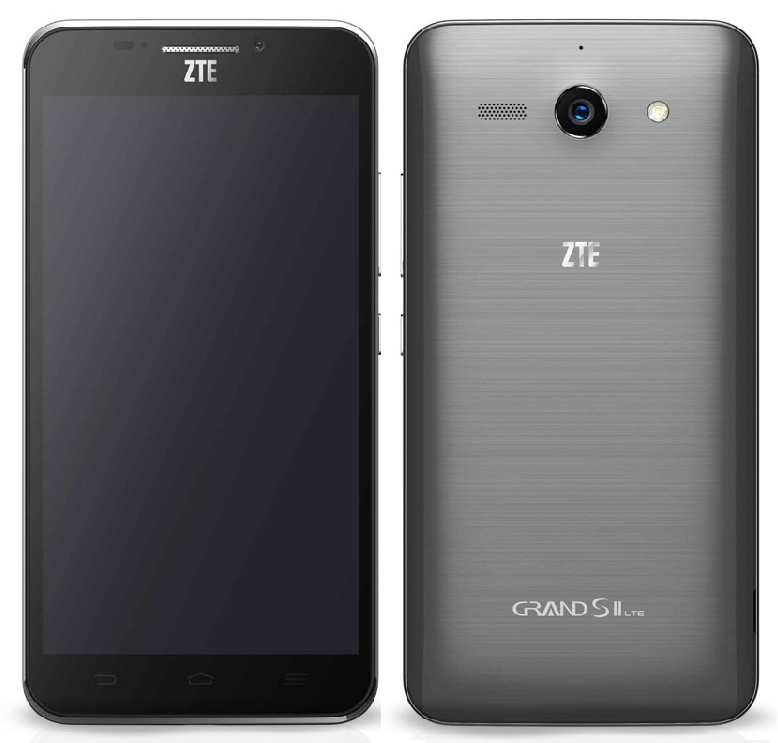
ZTE unveiled the Grand S II at the CES 2014 earlier this year. ZTE has launched the smartphone in China. It has a 5.5-inch (1920 x 1080 pixels) full HD IPS display based on One Glass Solution (OGS) technology, powered by a 2.3 GHz Quad-Core Snapdragon 801 processor (instead of Snapdragon 800 at the time it was announced) and runs on Android 4.3 (Jelly Bean) OS. It comes with a 13-megapixel rear camera with LED Flash, Sony sensor, full HD video recording and a 2-megapixel front-facing camera.
It has three microphones for noise reduction that makes voice calls clearer. It also supports 4G LTE. There were rumors that the phone would have 4GB RAM, after a ZTE smartphone appeared on Tenna certification database, but this has 2GB RAM and 16GB of internal memory. ZTE also offers an exclusive 32GB variant with 3GB RAM.

ZTE Grand S II specifications
- 5.5-inch (1920 x 1080 pixels) OGS display
- 2.3 GHz quad-core Qualcomm Snapdragon 801 processor with Adreno 330 GPU
- Android 4.3 (Jelly Bean) OS
- 13MP auto focus camera with LED Flash, 1080p HD video recording
- 2MP front-facing camera
- 2GB RAM with 16GB internal memory / 3GB RAM with 32GB internal memory
- 4G LTE / 3G HSPA+, Bluetooth, WiFi 802.11 a/b/g/n (Dual Band), GPS/aGPS
- 3000 mAh battery
Lenovo A526 with 4.5-inch display, quad-core processor launched
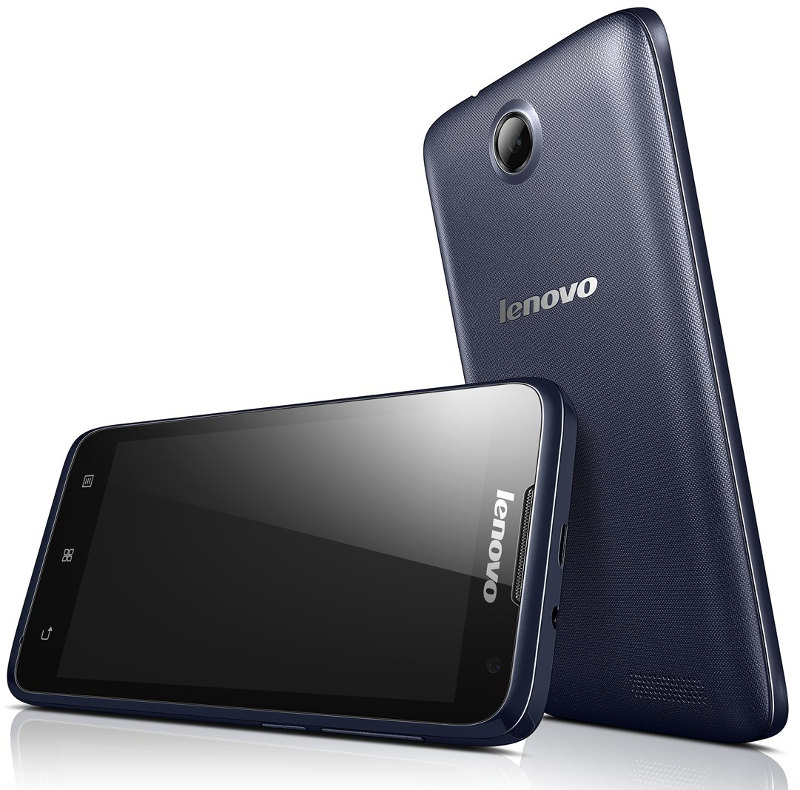
Lenovo has launched the Lenovo A526, the company’s latest smartphone in the A-series. It has a 4.5-inch (854 x 480 pixels) capacitive touchscreen display, powered by a 1.3 GHz Quad-core Mediatek MT6582M processor and runs on Android 4.2 (Jelly Bean). It has a 5-megapixel rear camera without flash and a 0.3-megapixel (VGA) front-facing camera.
It comes pre-installed Lenovo DOit apps for seamless data sharing, security and syncing. It has dual SIM support with dual standby.
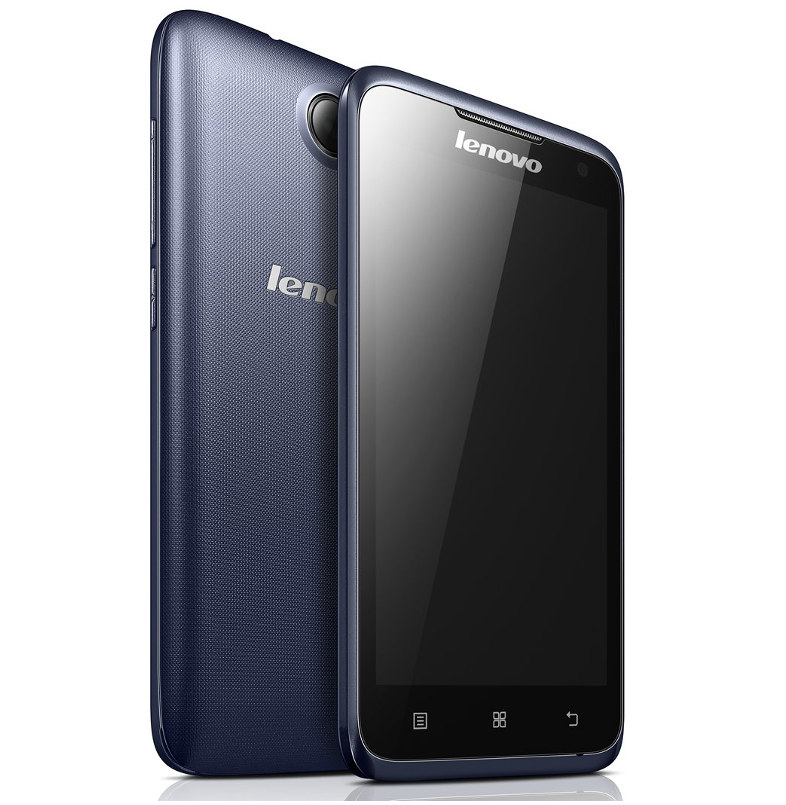
Lenovo A526 Specifications
- 4.5-inch (854 x 480 pixels) touch screen display
- 1.3 GHz quad-core Mediatek MT6582M processor
- Android 4.2 (Jelly Bean)
- Dual SIM (GSM + GSM)
- 5MP rear camera
- 0.3MP front-facing camera
- 11.1 mm thick and weight 145 grams
- 3.5mm audio jack, FM Radio
- 1GB RAM, 4GB internal memory, 32GB expandable memory with MicroSD
- 3G (HSDPA: 21 Mbps, HSUPA: 5.76 Mbps), WiFi 802.11 b/g/n, Bluetooth 4.0, GPS
- 2000 mAh battery
Lenovo A10-70, A8-50, A7-50 and A7-30 Android tablets announced
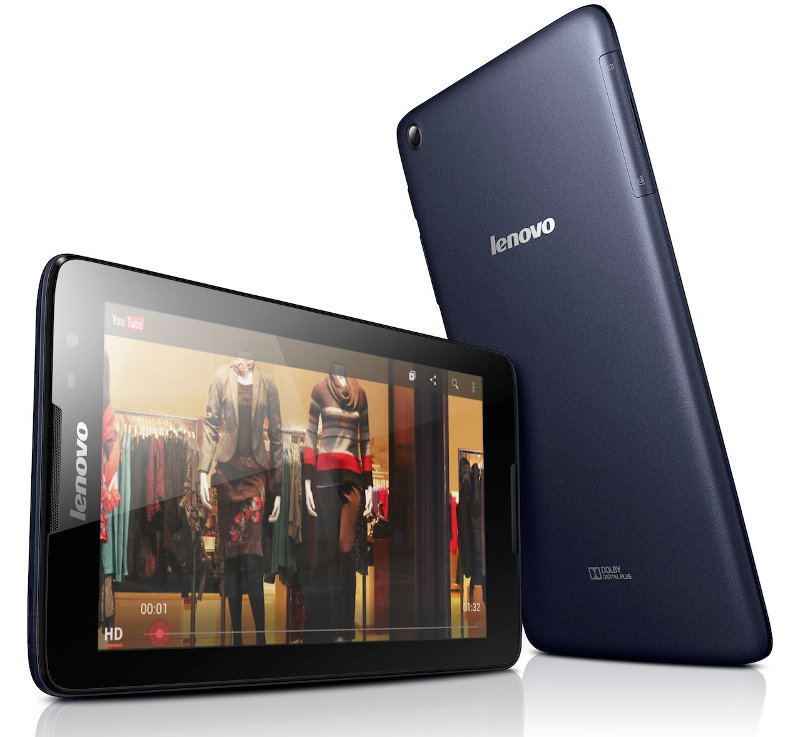
Lenovo has announced four new Android tablets, A10-70, A8-50, A7-50 and A7-30 in the A-series. The A10-70 has a 10.1-inch (1280 x 800 pixels) display, A8-50 has a 8-inch (1280 x 800 pixels) and both the A7-50 and A7-30 have 7-inch (1024 x 600 pixels) displays. All these run on Android 4.2 (Jelly Bean).
Lenovo A7-50 also comes in another variant A7-40 in Ebony color, 8GB internal memory and only with a front-facing camera. The Lenovo A8-50 also comes in data-only and data with voice calling support, apart from the WiFi-only variant. No details about RAM or internal storage, but all these are likely to have a expansion slot.
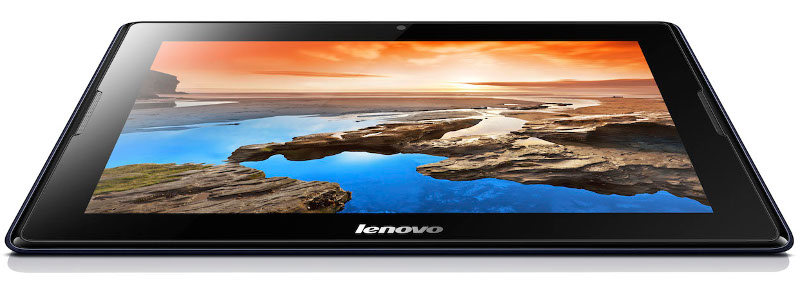
Lenovo A10-70 specifications
- 10-inch (1280 x 800 pixels) capacitive touchscreen display
- 1.3 GHz quad-core MediaTek MTK 8121 / MTK 8382 processor
- Android 4.2 (Jelly Bean) OS
- 8.9mm thick and weighs 563 grams
- 5MP auto focus rear camera
- 2MP front-facing camera
- 3.5mm audio jack, dual front-facing speakers, Dolby Digital Plus
- 3G (Optional), WiFi 802.11 b/g/n, Bluetooth 4.0
- 6300 mAh battery
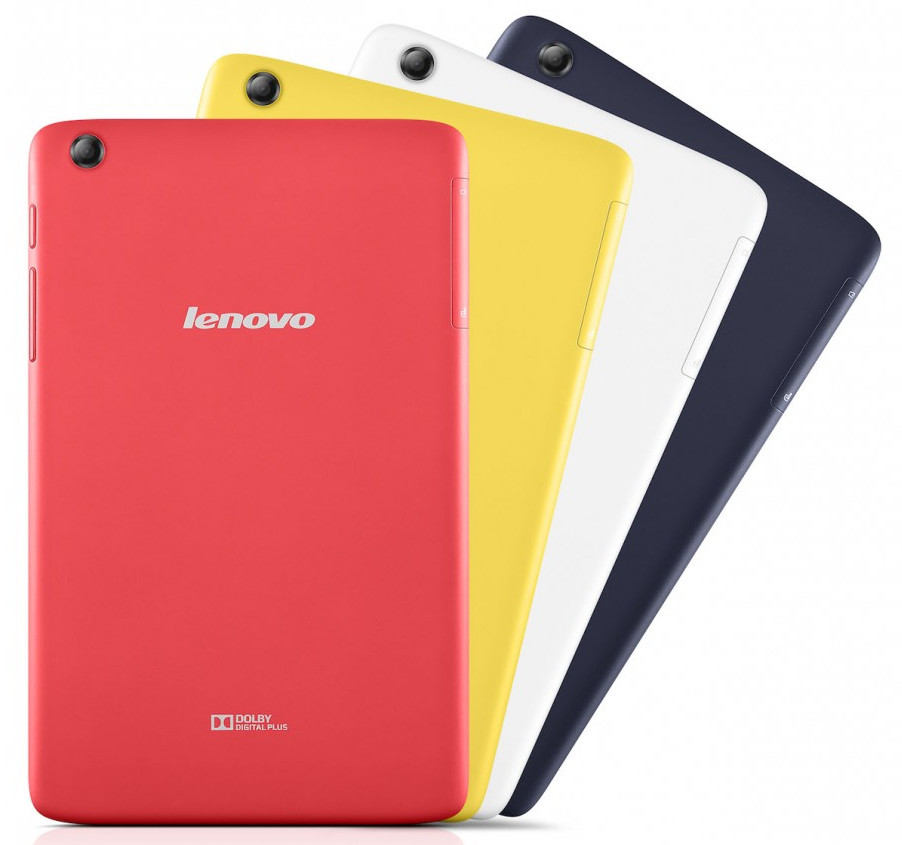
Lenovo A8-50 specifications
- 8-inch (1280 x 800 pixels) capacitive touchscreen display
- 1.3 GHz quad-core MediaTek MTK 8121 / MTK 8382 processor
- Android 4.2 (Jelly Bean)
- 8.9 mm thick and weighs 360 grams
- 5MP auto focus rear camera
- 2MP front-facing camera
- 3.5mm audio jack, dual front-facing speakers, Dolby Digital Plus
- 3G (Optional), WiFi 802.11 b/g/n, Bluetooth 4.0
- 4200 mAh battery
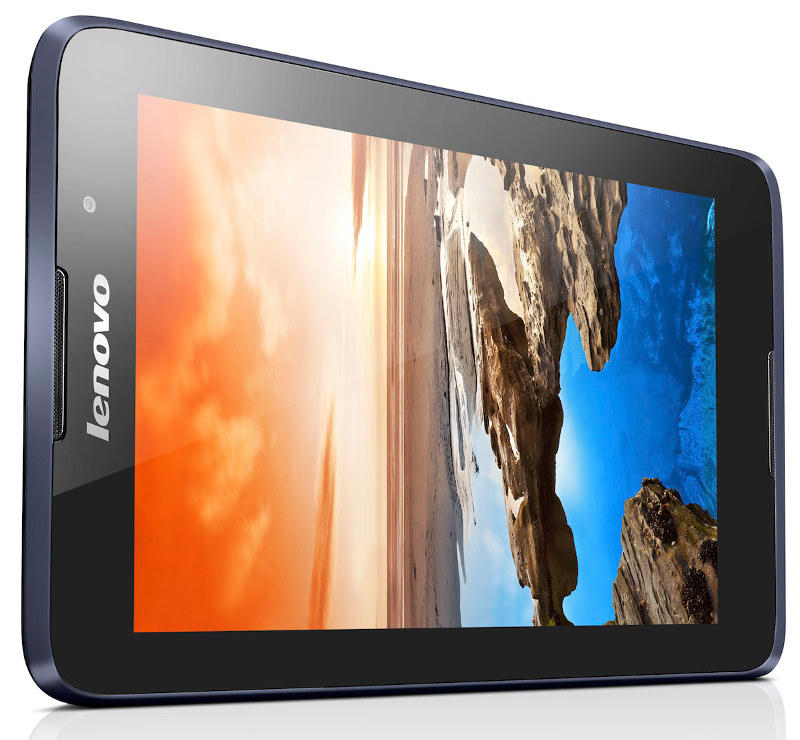
Lenovo A7-50 specifications
- 7-inch (1024 x 600 pixels) capacitive touchscreen display
- 1.3 GHz quad-core MediaTek MT8382 processor
- Android 4.2 (Jelly Bean) OS
- 2MP rear camera
- 2MP front-facing camera
- 3.5mm audio jack, dual front-facing speakers, Dolby Digital Plus
- 3G (Optional), WiFi 802.11 b/g/n, Bluetooth 4.0
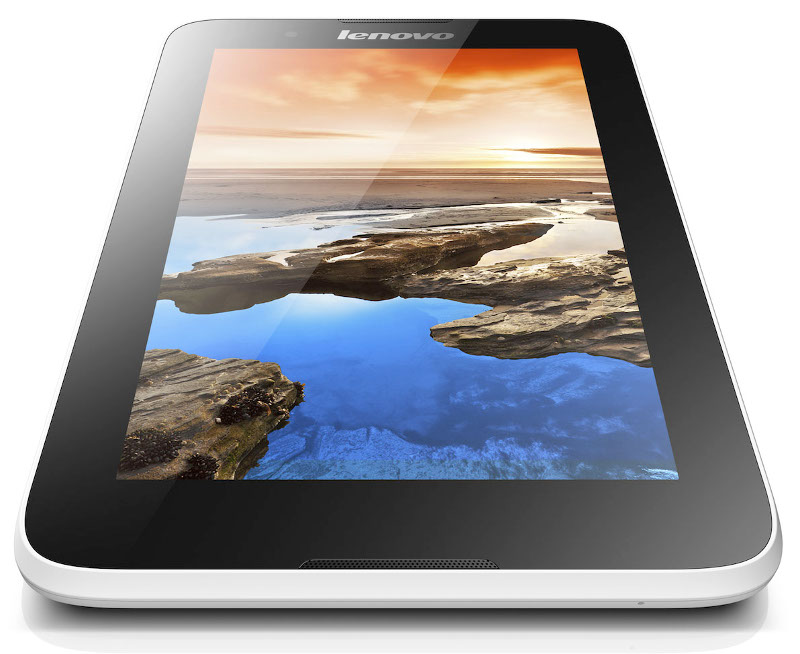
Lenovo A7-30 specifications
- 7-inch (1024 x 600 pixels) capacitive touchscreen display
- 1.3 GHz quad-core MediaTek MT8382 processor
- Android 4.2 (Jelly Bean) OS
- 10.7 mm thick and weighs 340 grams
- 2MP rear camera
- 0.3MP (VGA) front-facing camera
- 3.5mm audio jack, dual front-facing speakers, Dolby Digital Plus
- 2G (EDGE), 3G (via Dongle), WiFi 802.11 b/g/n, Bluetooth 4.0
- 3500 mAh battery
Toshiba unveils application processor for Wearable devices
The wearables market is the next battleground for the manufacturers and it has become pretty evident that everybody has their eyes on the smart watch category as Google had just announced Android Wear for wearables. While most manufacturers are busy building products to reach the consumers, Toshiba has taken a turn and has just announced an application processor for the wearable devices.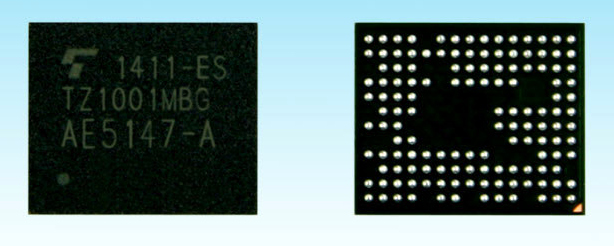
The application processor - TZ1001MBG, is the latest addition to the ApP Life products from Toshiba and the shipments are expected to start from May 2014 while mass production is set to start in September.
Toshiba’s latest chip combines a accelerometer, processor, memory and low energy bluetooth and a new higher end model, TZ1011MBG, will come with all the aforementioned components as well as a gyroscope and magnetometer. Toshiba claims that these new chips will be very small and consume less power, thus making it ideal for wearables.
The wearable market is indeed starting to come together and Toshiba is among the first to target the manufacturers instead of consumers. Lets see how things turn out in the wearable market.
KitKat install base doubles in a month, now on 5.3% of Android devices
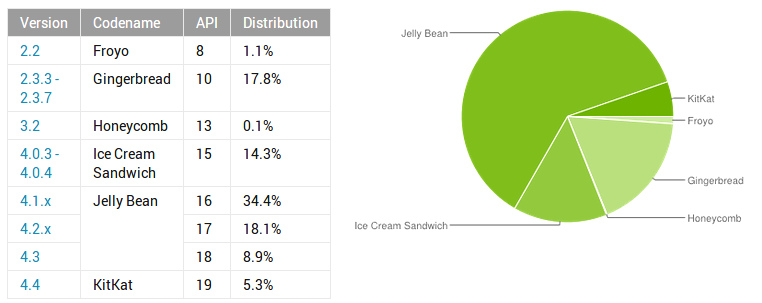
Google has released the Android’s Platform Distribution numbers for the period of March to April 2014. This reveals tremendous growth in KitKat share that has doubled from 2.5% to 5.3% in one month. This could be due to increase in number of new devices with Android 4.4 (KitKat). Several manufacturers like HTC, Samsung and Sony have started rolling out Android 4.4 (KitKat) update for their older devices globally.Sony and Samsung have promised Android 4.4 updates for some of their devices, so the KitKat share would increase in coming months. The chart shows that still 61.4% of Android devices are running on Jelly Bean, in which Android 4.1 (Jelly Bean) leads with 34.4% share. Since some companies are yet to offer KitKat update for older devices, Jelly Bean share is not likely to come down anytime soon.
Gingerbread and Ice Cream Sandwich are losing their share gradually. Back in December KitKat was running on only in 1.1% of devices. It took just four months for KitKat to grab 5.3% share. Some local OEMs like Xolo and iBall have promised KitKat upgrade for their latest devices. Other OEMs are likely to provide KitKat update directly, skipping Android 4.3 (Jelly Bean) later this year, that would improve its share.
OmniVision unveils ultra-compact camera sensor for smart devices with eye tracking and biometrics

OmniVision Technologies has launched OV6211, the company’s new ultra-compact, low-power global shutter sensor designed for notebooks, tablets, mobile phones, wearable electronics, gaming devices, security systems and more. It is the first global shutter sensor to capture 400 x 400 (square) resolution video at 120 frames per second (FPS), says the company. OmniVision sensor is already present in several smartphones from companies such as Gionee, Motorola, Xiaomi, Micromax and more.
The new sensor brings gesture recognition and tracking functions to mobile and wearable devices. It also has object and motion detection functionality and features a 3-micron OmniPixel3-GS global shutter pixel.
It features two low-power modes, the light sensing mode that wake the sensor only when the light has been detected and ultra-low power mode that reduces resolution and frame rates to conserve additional power.
Features of OmniVision OV6211
- 3 micron global shutter pixel
- 1/10.5-inch OV6211 fits into an ultra-compact 3.2 x 3.2 mm chip-scale package (CSP3)
- Automatic black level calibration (ABLC)
- Programmable controls for frame rate, mirror and flip, cropping and windowing
- Supports output formats: 8/10-bit RAW
- Supports images sizes: 400×400, 200×200, 100×100
- Fast mode switching
- Supports horizontal and vertical 2:1 and 4:1 monochrome subsampling
- Supports 2×2 monochrome binning
- Standard serial SCCB interface
- Programmable SCCB device ID
- One-lane MIPI serial output interface
- Embedded 128 bits of one-time programmable (OTP) memory for part identification, etc.
- Two on-chip phase lock loop (PLL)
- Programmable I/O drive capability
- Built-in 1.5V regulator for core
- Built-in strobe control
- Ultra low power mode for ambient light sensor
Samsung Galaxy Tab4 10.1, 8.0 and 7.0 with quad-core processors, Android 4.4 official

Samsung has finally unveiled its Galaxy Tab4 series – Galaxy Tab4 10.1, Galaxy Tab4 8.0 and Galaxy Tab4 7.0 after several leaks. These tablets have 10.1-inch, 8.0-inch and 7.0-inch WXGA displays with 16:10 screen ratio. All these are powered by 1.2 quad-core processors and run on Android 4.4 (KitKat) and come in WiFi and 3G / LTE variants. These have Group Play, Samsung Link and Samsung WatchON software features.

These have a 3-megapixel rear camera and a 1.3-megapixel front-facing camera. These have Samsung’s signature power button and capacitive touch buttons and also have leather-like back. Other specifications are almost similar except the display size and the battery life. Processor is also likely to vary depending on the models.
Samsung Galaxy Tab4 10.1 specifications
- 10.1-inch (1280 x 800 pixel) WXGA display
- 1.2 GHz quad-core Processor
- Android 4.4 (KitKat)
- 7.95mm thick and weighs 487g
- 3MP Fixed Focus rear camera
- 1.3MP front-facing camera
- 4G LTE/3G HSPA+, Bluetooth 4.0, Wi-Fi 802.11 a/b/g/n, Wi-Fi Direct, GPS, GLONASS
- 1.5GB RAM, 16GB internal memory, microSD (up to 64GB)
- 6,800mAh battery
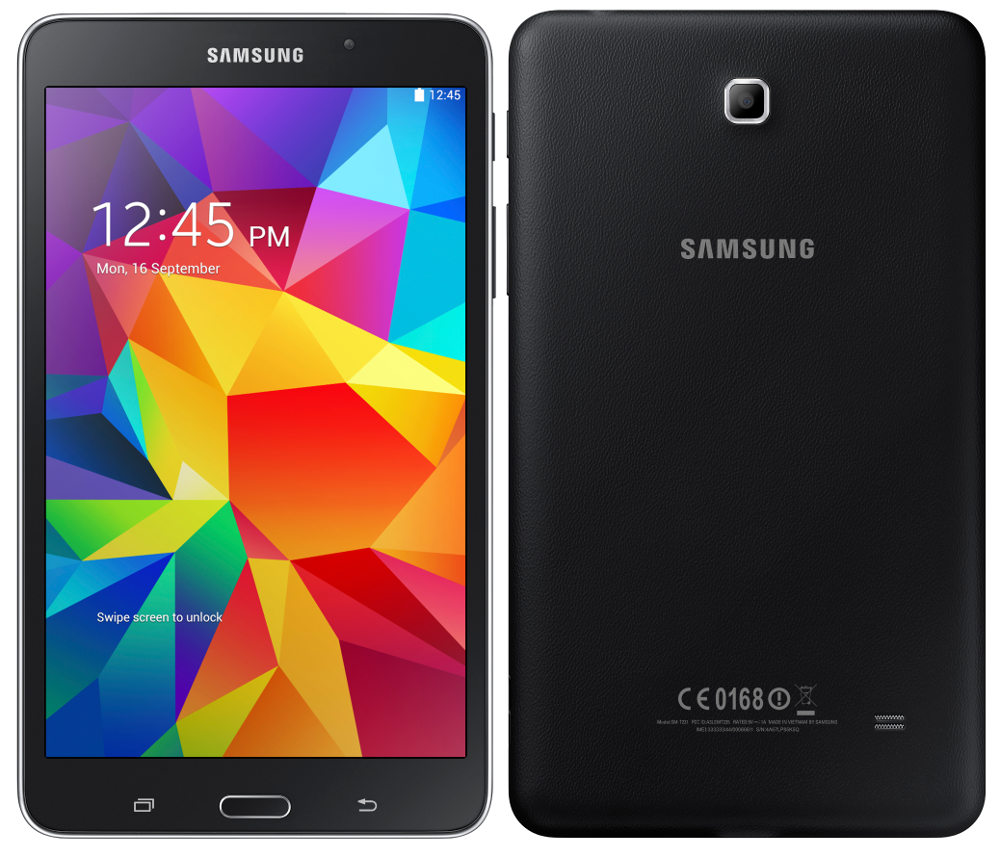
Samsung Galaxy Tab4 8.0 specifications
- 8.0-inch (1280 x 800 pixel) WXGA display
- 1.2 GHz quad-core Processor
- Android 4.4 (KitKat)
- 7.95mm thick and weighs 320g
- 3MP Fixed Focus rear camera
- 1.3MP front-facing camera
- 4G LTE/3G HSPA+, Bluetooth 4.0, Wi-Fi 802.11 a/b/g/n, Wi-Fi Direct, GPS, GLONASS
- 1.5GB RAM, 16GB internal memory, microSD (up to 64GB)
- 4,450mAh battery

Samsung Galaxy Tab4 7.0 specifications
- 7.0-inch (1280 x 800 pixel) WXGA display
- 1.2 GHz quad-core Processor
- Android 4.4 (KitKat)
- 9 mm thick and weighs 276g
- 3MP Fixed Focus rear camera
- 1.3MP front-facing camera
- 4G LTE/3G HSPA+, Bluetooth 4.0, Wi-Fi 802.11 a/b/g/n, Wi-Fi Direct, GPS, GLONASS
- 1.5GB RAM, 8GB/16GB internal memory, microSD (up to 32GB (3G/WiFi) / up to 64GB (LTE))
Huawei Ascend Y600 with 5-inch display, Android 4.2 announced
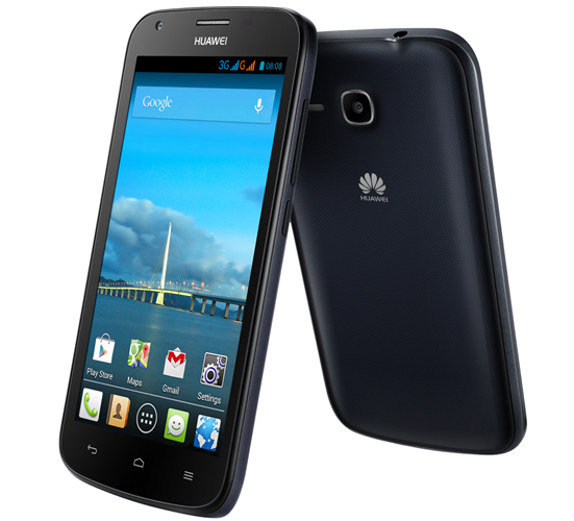
Huawei has unveiled the Ascend Y600, the latest smartphone in the Y Series. It has a 5-inch (854 x 480 pixels) FWVGA display, powered by a 1.3 GHz dual-core MediaTek (MT6572) processor and runs on Android 4.2 (Jelly Bean) OS with Huawei’s own Emotion UI on top. It has a 5-megapixel rear camera and a 0.3-megapixel (VGA) front-facing camera.
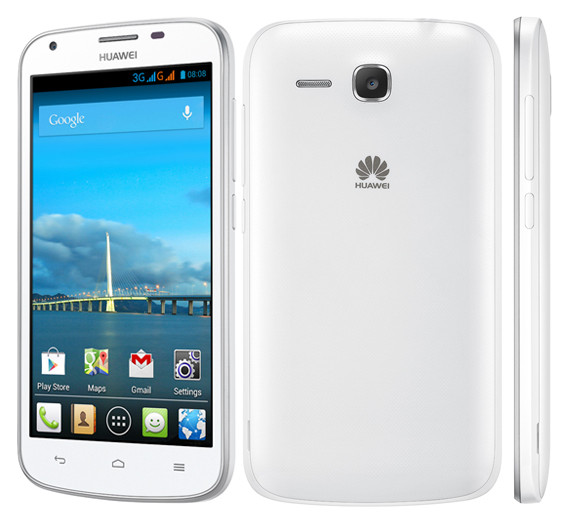
Huawei Ascend Y530 that was unveiled earlier this year had a 4.5-inch FWVGA screen, powered by a Snapdragon 200 processor and runs on Android 4.3 (Jelly Bean). It is not clear why Huawei has switched to MediaTek CPU for the Y600 since both come under Y series. Also the 5-megapixel rear camera lacks LED flash. Looking at the specification, it is likely to be be priced affordably.
Huawei Ascend Y600 specifications
- 5-inch (854 ×480 pixels) FWVGA capacitive touch screen display
- Android 4.2 (Jelly Bean) with Emotion UI
- 1.3 GHz dual-core MediaTek (MT6572) processor with Mali 400 GPU
- 5MP rear Camera
- 0.3MP front-facing camera
- Dimensions: 144.5 x 74.5 x 10.8 mm; Weight: 180 grams
- 3G HSPA+, Wi-Fi 802.11 b/g/n, Bluetooth 3.0, GPS
- 512MB RAM, 4GB of internal memory, Expandable memory up to 32GB with micro SD
- 2100 mAh battery
Lava Iris 550Q is official, packs a 5.5" 720p display
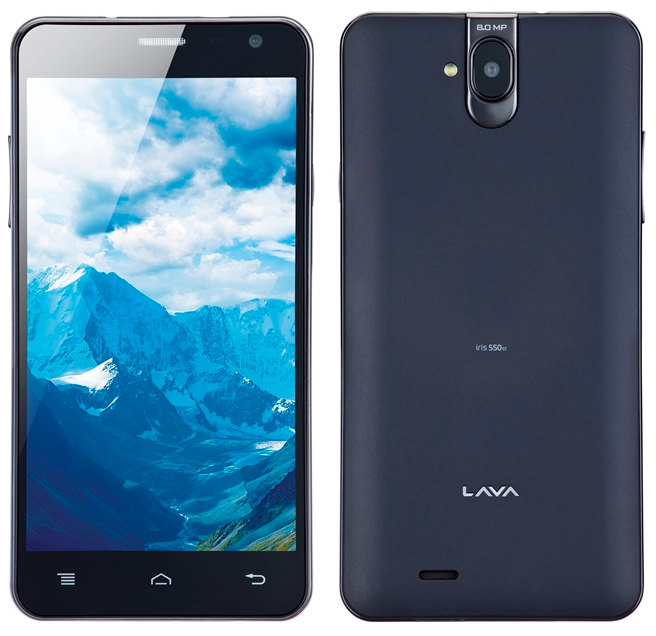
Lava has launched the Iris 550Q the company’s latest smartphone in the Iris series. It has a 5.5-inch (1280 x 720 pixels) IPS display based on OGS technology, powered by a 1.2 GHz quad-core processor and runs on Android 4.2 (Jelly Bean) OS. It has narrow 3mm bezel that makes the body smaller. It packs a 8-megapixel rear camera with LED flash, BSI sensor and a 2-megapixel front-facing camera. Lava launched Iris Pro 30 with a 4.7-inch HD display earlier this year.
Lava Iris 550Q specifications
- 5.5-inch (1280 x 720 pixels) HD IPS display based OGS technology
- 1.2 GHz quad-core processor
- Android 4.2 (Jelly Bean)
- Dual SIM
- 8MP rear camera with LED Flash, 1080p video recording, BSI sensor
- 2MP front-facing camera
- 3.5mm audio jack, FM Radio
- 1GB RAM, 4GB internal memory, expandable memory up to 32GB with microSD
- 3G, WiFi 802.11 b/g/n, Bluetooth 4.0, GPS
- 2600 mAh battery with up to 10 hours of talk time on 2G
Subscribe to:
Posts (Atom)
